
“It was a very different feel for the character.”

'Lower Decks' finally resolves a huge Star Trek villain mystery [Exclusive]
There is only one Borg Queen. Or are there several? First introduced in the 1996 film Star Trek: First Contact , the enigmatic leader of the Borg seemed to transcend time and space. She also represents a paradox: A single person speaking for an entire hivemind collective.
Played first by Alice Krige, there are now three Borg Queens in total. Susanna Thompson took on the role in several episodes of Voyager ; and in Picard Season 2 , another Borg Queen will be played by Annie Wersching.
But who is the “real” Borg Queen? In a recent surprising (and hilarious) cameo in Lower Decks , the answer seems to be that the original Borg Queen is still the canonical one — at least during Starfleet training simulations!
To get to the bottom of this classic Star Trek mystery, we spoke to the Borg Queen herself. Here’s what Alice Krige had to say about her surprise return to the Star Trek canon and why she thinks her character is always there, even when you don’t see her.
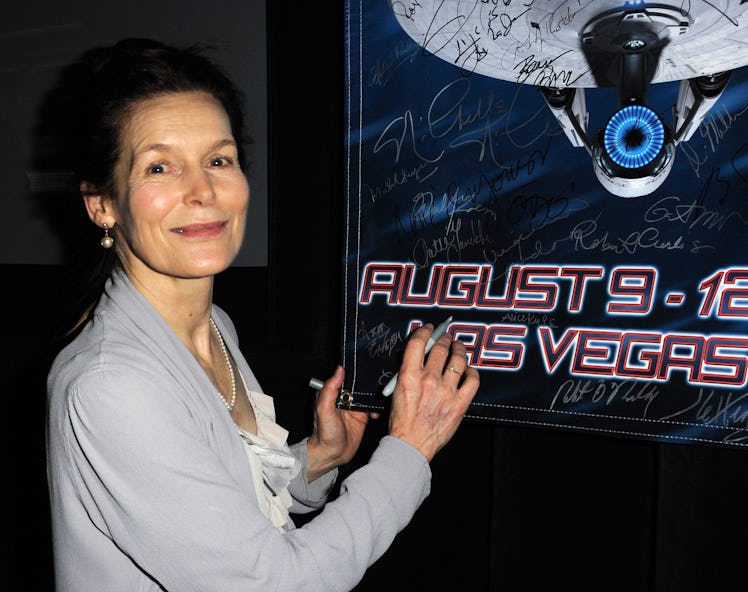
Alice Krige at the 11th Annual Official Star Trek Convention in 2021.
In Lower Decks, Season 2, Episode 8, “I, Excretus,” Boimler ( Jack Quaid) finds himself in a holographic drill where he has to do everything he can to “resit the Borg.” After obsessively running the drill over and over, Boimler meets a holographic recreation of the Borg Queen. Cue an Easter egg from First Contact.
The Borg Queen blows gently on Boimler’s skin, referencing something similar she did to Data when his android skin was briefly grafted with human skin. It’s a hilarious scene, and all-to-brief, but there’s a degree of Trekkie legitimacy brought to it because it really is the voice of Alice Krige.
The original Borg Queen tells Inverse she never expected to return to Star Trek, especially not like this.
“They just, they just called and asked if I would do it. It was great fun,” Krige says, revealing she recorded most of her dialogue in her husband’s closet. “It has the best sound in the house. It’s so full of clothing, plenty of insulation.”
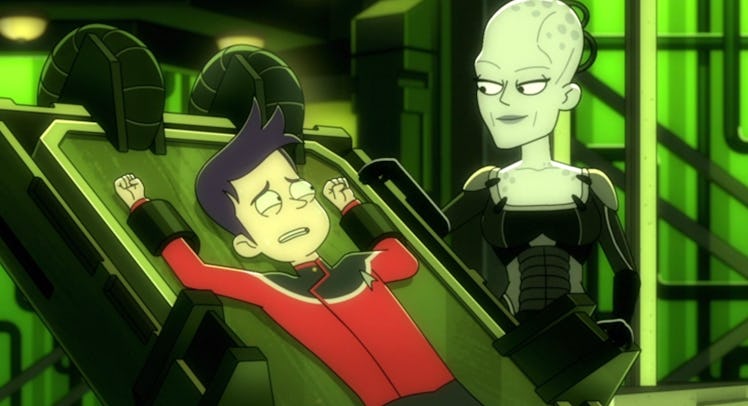
Boimler (Jack Quaid) prepares to be assimilated by the Borg Queen (Alice Krige).
This isn’t the first time since First Contact that Krige has returned to her famous Star Trek role. When the Borg Queen initially crashed the Voyager party for the episode “Dark Frontier,” she was not played by Krige, but instead by Susanna Thompson (perhaps more famous for her role as Lenara Kahn in the DS9 episode “Rejoined.) But when it was time for Voyager’s big finale, Krige was asked once again to don her Borg leather. This put her in the unique position of being one of the few Star Trek villains (Q is another) who have tangoed with both Captain Picard and Captain Janeway.
Krige says that when she returned for Voyager , she realized she’d based much of her performance on the Borg Queen’s attempts to seduce Next Generation ’s leading men.
“There's sexual energy that she kind of manipulated both Data and Picard,” Krige says. “Well, she didn't manipulate either of them, but she thought she was. So I had to decide how to play that in Voyager because instead of two men this was two women [Janeway and Seven of Nine.]”
This led Krige to a quick phone call with “the producers” of Voyager , in which it was decided the Borg Queen was “Omnisexual,” which meant, yes, she would probably have some kind of flirtation with Janeway or Seven, too, if she wanted to.
“After that, I thought great . I just went and had a great time because they're two wonderful actresses,” Krige tells Inverse . “It was a very different feel for the character because it was a very different sort of energetic exchange.”
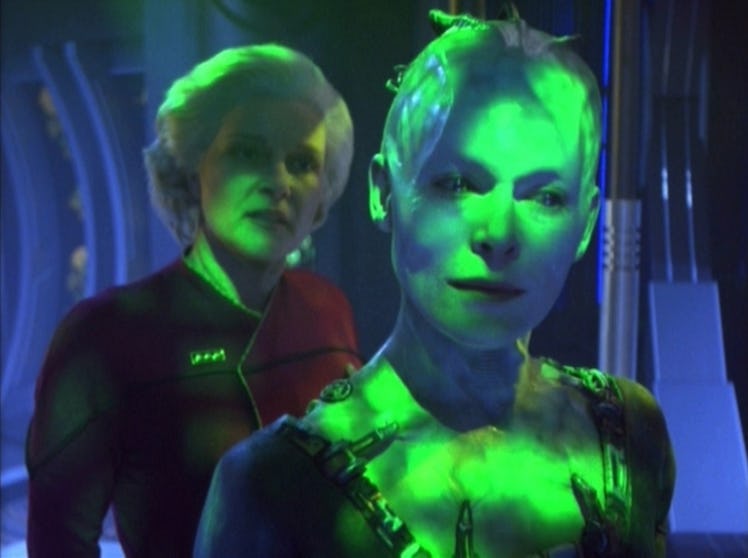
A time-traveling Admiral Janeway (Kate Mulgrew) and the Borg Queen (Alice Krige)
It’s been exactly 20 years since Krige last played the Borg Queen in Voyager, and because she perished in that episode and we also saw Picard take her out in First Contact , fans have wondered for years just how many copies of the Borg Queen there are, or if the Queens are actually different characters.
With Annie Wersching’s Borg Queen coming to Picard Season 2 and Alice Krige’s delightful return to Lower Decks , could there ever be a meeting of all these Borg Queens? How does she keep coming back? Alice Krige isn’t sure, but she wouldn’t rule out a live-action return.
“She manifests in many different ways, or maybe she doesn't?” Krige says playfully. “Even if she’s not there, it doesn't mean she's not there . She’s so mysterious and endlessly interesting. Who knows how she shows up?”
Lower Decks is streaming now on Paramount+.
This article was originally published on Oct. 8, 2021
- Science Fiction
We earn a commission for products purchased through some links in this article.
Picard's season 2 Borg twist just changed Star Trek forever
"Resistance was futile."

Picard season 2 episode 10 spoilers follow.
The Borg assimilated themselves almost immediately into pop culture following their Next Generation debut in 1989. And this disturbing hive mind hasn't really left Picard's thoughts since either. Because after he himself was assimilated by The Federation's greatest foe, trauma from that encounter still lingers, even now.
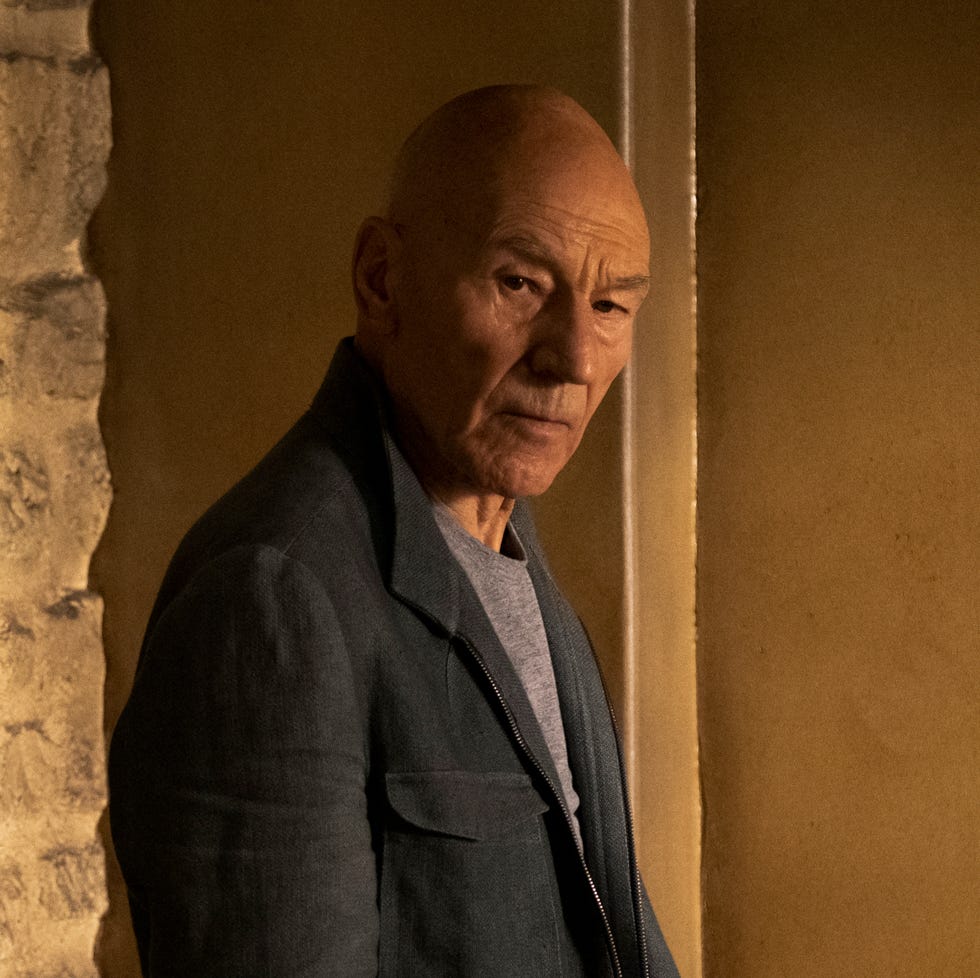
But even with all that thrown into the mix, longtime fans were still surprised to see the Borg come to Picard ' s aid at the start of this new season . And that wasn't just any old Borg either.
This new Queen seemed different from anything that Starfleet had encountered before. Yet that didn't stop Picard from trying to blow up his own ship to kill her — and everyone else aboard — without a second thought.
To be fair though, Jean-Luc thought he was stopping the deadliest threat he's ever known from expanding even further throughout the cosmos. But as season two evolved, it soon became clear that this new Borg Queen was actually an ally of sorts, or at least someone he used to consider as a friend.
Fans guessed it early on , but it wasn't until the final episode of season two that Picard revealed this new Borg to be none other than Agnes Jurati, a former crewmate who is now bonded with the Queen.
Throughout the latter half of this season, the pair fought for control over Jurati's body until they finally reached an understanding. Rather than try and assimilate the whole universe without the universe's consent, the pair decided to create a new Borg Collective that embraces the individuality of each distinct member. It's still a hive mind, but not like before. Anyone who joins will do so willingly.
It's impossible to understate what an absolute game-changer that is for Star Trek . Up until this point, the Borg have arguably been the biggest threat that the Federation has ever faced.
The idea of them collaborating with anyone other than themselves was unthinkable. "Resistance is futile," after all. But now a new hybrid Queen is suddenly asking not just for a truce, but to actually join the Federation temporarily.
It's not a trick either. With the arrival of that mysterious transwarp conduit, Borgrati, as we like to call her, realises that an alliance is the best thing for everyone, including her former allies in Starfleet. Something out there created this anomaly, something potentially more powerful than both the Borg and the Federation combined.
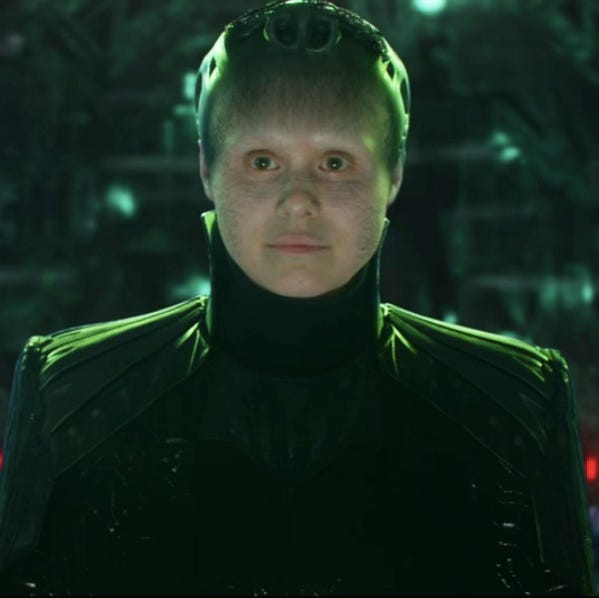
There are also some visual clues that suggest Borgrati's intentions are genuine too. Gone are the Borg cube and sphere vessels, now replaced with a more organic design to reflect their evolved way of thinking. Yes, individuals have broken free before, but this is an entirely new Collective, one that transforms the Borg's identity and therefore reputation in this world.
Is there another, more traditional Collective still out there somewhere? Probably yes, perhaps somewhere beyond the Alpha Quadrant, but still, they now have a new capacity for change on a much wider scale than we've ever seen before. So even if the deadly Borg do reappear, there's hope now, especially if Borgrati and her own Collective remain on side.
That seems likely if we look ahead to their role in the future. Because Star Trek Discovery recently revealed that the Borg are no longer a threat in the 32nd century, which implies that the Borg's development in Picard season two will continue to have ramifications for centuries to come.
It's rather fitting that peace with the Borg began here in Jean-Luc's final journey. Given what they once did to him, it will mean a lot for Picard to be the one who helps broker new ties between the Collective and the Federation.
In doing so, the Admiral will leave a lasting legacy of peace beyond perhaps anything else he's accomplished to date. And most importantly of all, it signifies that he will have also overcome his own trauma by learning to finally accept the Borg in their new, evolved form.
Unless everything goes to shit in season three . But even if that does happen, at least we'll have Worf.
Star Trek: Picard season 2 airs Thursdays on Paramount+ in the US and Fridays on Amazon Prime Video in the UK.

Titan Comics Star Trek - Picard: The Classic Chronicles
![Star Trek: The Next Generation - Season 1-7 [Blu-ray] [Region Free] Star Trek: The Next Generation - Season 1-7 [Blu-ray] [Region Free]](https://hips.hearstapps.com/vader-prod.s3.amazonaws.com/1568037652-51748LgoZAL.jpg?crop=1xw:1xh;center,top&resize=980:*)
Paramount Home Entertainment Star Trek: The Next Generation - Season 1-7 [Blu-ray] [Region Free]
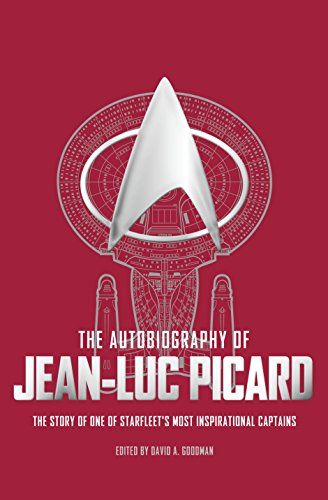
Titan Books The Autobiography of Jean-Luc Picard
After teaching in England and South Korea, David turned to writing in Germany, where he covered everything from superhero movies to the Berlin Film Festival.
In 2019, David moved to London to join Digital Spy , where he could indulge his love of comics, horror and LGBTQ+ storytelling as Deputy TV Editor, and later, as Acting TV Editor.
David has spoken on numerous LGBTQ+ panels to discuss queer representation and in 2020, he created the Rainbow Crew interview series, which celebrates LGBTQ+ talent on both sides of the camera via video content and longform reads.
Beyond that, David has interviewed all your faves, including Henry Cavill, Pedro Pascal, Olivia Colman, Patrick Stewart, Ncuti Gatwa, Jamie Dornan, Regina King, and more — not to mention countless Drag Race legends.
As a freelance entertainment journalist, David has bylines across a range of publications including Empire Online, Radio Times , INTO, Highsnobiety, Den of Geek , The Digital Fix and Sight & Sound .
Physiology [ ]
The physiology of each Borg drone varied according to the species which it was assimilated from. ( Star Trek: First Contact ) Drones were typically humanoid, although the Collective demonstrated a willingness to assimilate non-humanoid lifeforms. ( VOY : " Scorpion ")
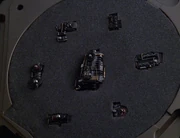
A set of Borg implants after removal
Upon assimilation, a drone would cease to grow body hair and would develop a pallid skin coloration, differing from its original skin pigmentation. Cybernetic implants were either surgically attached to the body or grown internally by nanoprobes injected into the bloodstream; in certain cases these implants could cause severe skin irritation. ( TNG : " The Best of Both Worlds "; Star Trek: First Contact ) The nature of these implants varied from drone to drone depending on the drone's intended function, but the basic nodes of interlink for communications with the Collective and a myo-neural cortical array to control movements were implemented in every drone. In most cases, an eye would be replaced with an eyepiece that improved its vision and an arm would be amputated altogether to make room for a functional prosthetic; in tactical drones, a weapon would be included, and some drones had medical tools built in to heal drones who had minor injuries. ( VOY : " The Gift ", " Dark Frontier ") The implants of a fully assimilated drone allowed it to function for extended periods without shelter, food, water, or even air. A drone could even survive in the vacuum of outer space. Lily Sloane , a human observer local to the Earth of the 21st century , characterized Borg drones as "bionic zombies " after hearing a description of them, albeit before observing them directly. ( Star Trek: First Contact )
A drone's only requirement was a supply of energy to maintain the implants that in turn maintained its biological functions. This energy was supplied during regeneration cycles within a Borg alcove . Upon receiving damage, a drone would return to the alcove for assessment of the damage. Severely damaged drones were disassembled and scavenged for reusable parts. ( TNG : " Q Who ", " I Borg ")
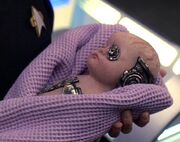
Infant Borg
The Borg did not procreate; they would add to the Collective's population only by assimilation. ( VOY : " Drone ") Borg infants were not accepted to the collective until they matured to a certain age. Until reaching this age, assimilated infants and youths were placed inside maturation chambers . ( TNG : " Q Who "; VOY : " Collective ")
Borg drones were equipped with myriad technologies integrated into their bodies which enabled them to perform their duties within the Collective, several of which were universal to all drones. A neural transceiver kept them connected to the hive mind . ( VOY : " Scorpion, Part II ") A personal force field protected each drone from most energy-based attacks. ( TNG : " Q Who ") A drone was able to communicate with their ship by signals across a subspace domain, the basis of their hive mind, which Data likened to a transporter beam . ( TNG : " The Best of Both Worlds, Part II ") Each drone possessed a pair of assimilation tubules embedded in one hand for the purpose of instantly injecting individuals with Borg nanoprobes. ( Star Trek: First Contact ) A cortical processor allowed a drone to rapidly assimilate visual information. Borg drones were also equipped with a neural processor, which kept a record of every instruction that particular Borg receives from the collective hive mind. Captain Picard used one such processor to discover that the Borg were attempting to use the deflector dish of the USS Enterprise as an interplexing beacon to contact the Borg in 2063. ( Star Trek: First Contact )
Drones also contained fail-safe mechanisms designed to deactivate and even vaporize their own bodies, thereby allowing the Collective to eliminate damaged or dead drones without leaving their remains to be exploited by outsiders. ( TNG : " Q Who ") The captured drone Third of Five also made comments indicating that this vaporization may have been a form of resource re-absorption. ( TNG : " I Borg ") One of these fail-safes was also intended to deactivate drones automatically if they experienced strong emotional states, which the Borg interpreted as a sign of disconnection from the hive mind. ( VOY : " Human Error ")
The Borg typically operated in an atmosphere with a constant temperature of 39.1 °C (102.38 °F ), 92% relative humidity, an atmospheric pressure of approximately 102 kPa , and trace amounts of tetryon particles. According to Amina Ramsey , the Borg smelled like old trash bags . ( LD : " Much Ado About Boimler ").
History [ ]
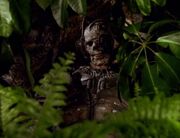
A Borg skeleton on a ruined planet
The precise origins of the Borg were unclear. As of 1484 , they were reported as controlling only a handful of systems in the Delta Quadrant , but by 2373 , they had assimilated thousands of worlds. In addition to this stronghold in the Delta Quadrant, the Borg also dispatched vessels throughout the galaxy via transwarp conduits . ( VOY : " Dragon's Teeth ", " Scorpion ", " Endgame ")
A Borg vessel traveled back in time from 2373 in an unsuccessful attack on Earth in 2063 . ( Star Trek: First Contact ) Drones which survived this defeat were discovered and reactivated by Human scientists in 2153 , and transmitted a subspace message to Borg space before being destroyed by Enterprise NX-01 . ( ENT : " Regeneration ")
The Borg entered the home system of the El-Aurians at some point in their mutual history, swarming through it, scattering its native inhabitants and leaving little to nothing of the El-Aurians in their wake. ( TNG : " Q Who ", " I Borg ") In 2293 , the Federation offered aid to the El-Aurian refugees fleeing the Borg. ( Star Trek Generations ) These refugees included Guinan , who would later provide secondhand knowledge of the Borg invasion of the El-Aurian system to the crew of the USS Enterprise -D during an encounter in the 24th century. ( TNG : " Q Who ", Star Trek Generations ) However, these earlier incidents contributed almost nothing to the Alpha Quadrant 's awareness or understanding of the Borg Collective.
By the 2340s , rumors of an alien race called "The Borg" had reached the Alpha Quadrant, inspiring exobiologists Magnus and Erin Hansen to set out in search of them. Their research took them all the way to the Delta Quadrant, before they and their daughter Annika were assimilated in 2350 . ( VOY : " The Gift ", " The Raven ", " Dark Frontier ") Borg activity in the Alpha Quadrant, including the assimilation of the USS Tombaugh in 2362 and assimilation of outposts along the Romulan Neutral Zone in 2364 , were complete mysteries to Starfleet. ( VOY : " Infinite Regress "; TNG : " The Neutral Zone ")
The Collective's true nature was finally revealed to the Federation in 2365 when Q took the USS Enterprise -D to meet a Borg cube near the J-25 system . ( TNG : " Q Who ")
In late 2366 , a Borg cube invaded Federation space and assimilated Jean-Luc Picard , whose tactical information contributed, along with the Borg's own vastly superior power, to Starfleet 's disastrously one-sided engagement with the cube, the Battle of Wolf 359 . A fleet of forty starships assembled to combat the cube. All but one of these Federation ships were destroyed, while the cube itself remained intact, damaged but healing rapidly. ( TNG : " The Best of Both Worlds ", " The Best of Both Worlds, Part II "; DS9 : " Emissary ") The Enterprise -D recovered Picard and used his connection to the hive-mind to disable the cube before it could attack Earth. ( TNG : " The Best of Both Worlds, Part II ")
During the 2370s , the Borg were beset by several major setbacks in the Delta Quadrant, as witnessed by the crew of the USS Voyager .
The Borg-Species 8472 War decimated the Collective from 2373 - 2374 . ( VOY : " Scorpion ", " Scorpion, Part II ") Voyager 's liberation of Seven of Nine allowed Unimatrix Zero to create an active resistance movement in 2377 . ( VOY : " Unimatrix Zero ", " Unimatrix Zero, Part II ")
In 2378 , a crippling blow was delivered to the Borg when Voyager discovered one of their transwarp hubs and destroyed it, killing the Borg Queen (again) and devastating the Unicomplex in the process. During this battle, the Borg were infected with a neurolytic pathogen , which was carried by an alternate future version of Admiral Janeway and designed to disrupt the hive mind, to 'bring chaos to order'. It was this pathogen that killed the Borg Queen and allowed Voyager to destroy the transwarp hub. ( VOY : " Endgame ") The pathogen decimated the Borg Collective, leaving them reduced a handful of drones slowly cannibalized to sustain the Queen's last remaining body by 2401 . ( PIC : " The Last Generation ")
In 2384 , a Borg cube rendered dormant by the neurolytic pathogen was encountered by the USS Protostar . The crew proceeded to venture into the cube in order to access the vinculum to gain information on how to remove a weapon called the living construct from their ship. When the Medusan Zero volunteered to be assimilated to get the information, this act caused the cube and the drones aboard to wake up. The crew barely managed to escape as they helped Zero to break free from the Collective, who then managed to put the Borg back to sleep. ( PRO : " Let Sleeping Borg Lie ")

The Borg emerge from Jupiter on Frontier Day, 2401
The Borg Collective was still believed to operate as late as 2399 . ( PIC : " Maps and Legends ") On Frontier Day in 2401, this was confirmed after discovery that the main faction of the Borg were working with the rogue Changelings in a plot to assimilate the Federation via a different means than normal. With the Changelings infiltrating the Federation and spreading Picard's Borg-altered DNA through the transporter system, the Borg were able to quickly gain control over 339 starships, and their crews with only those over 25 years old being immune to their takeover. ( PIC : " Võx ") This proved to be the last stand for the original Borg with the Cube, the Queen and all of her remaining drones being destroyed by the rebuilt USS Enterprise -D , presumably bringing an end to the Borg threat. ( PIC : " The Last Generation ")
In the far future , extant Borg assimilated into galactic society, with Borg children learning side-by-side with children of other species. ( LD : " Temporal Edict ")
Alternate timelines [ ]
Confederation of earth [ ].

Borg Singularity in 2401
In 2401 , an atypical Borg Queen reached out to Admiral Jean-Luc Picard seeking membership in the Federation. Much to the Federation's confusion, this Borg Queen was vastly different to the Queen that had been encountered before and her Collective wasn't nearly as outwardly hostile. However, once aboard the USS Stargazer , the Queen began assimilating the ship and through it, the Stargazer's fleet. In response, Picard activated the ship's auto-destruct , stopping the assimilation. ( PIC : " The Star Gazer ")
In that moment, Q had removed Picard, Agnes Jurati, Seven, Raffaela Musiker, Cristóbal Rios, and Elnor from this timeline, and placed them in an alternate 2401. In this timeline, the Borg had been hunted to extinction by the Confederation of Earth , leaving only the Borg Queen . ( PIC : " Penance ")

The Singularity and Federation vessels deflecting the energy burst
After being returned from 2024 to 2401 by Q , Picard deactivates the auto-destruct, having deduced that the strange Borg Queen was actually the Queen from this timeline that had merged with Dr. Agnes Jurati in 2024 and had set out to create a different Collective, one based on mercy and choice. These Borg had sought out the Federation's help to stop an energy wave that threatened countless lives and by combining the shields of the Federation fleet and the Borg ship, the two former mortal enemies were able to stop it. However, the Borg didn't know the source of the energy wave or the massive transwarp conduit that emerged from it, only that it was a threat to everyone. Picard granted the Borg Queen's request to grant the Borg provisional membership in the Federation so that the Borg could be "the Guardian at the Gates" watching out for whatever this new threat was. ( PIC : " Farewell ")
Parallel universes [ ]
Picard's death [ ].
In one alternate quantum reality , Captain Jean-Luc Picard was lost in the Battle of Wolf 359 and William T. Riker succeeded him as the captain of the Enterprise -D with Worf as his first officer . ( TNG : " Parallels ")
Victory over the Federation [ ]
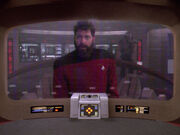
A disheveled Riker of a Borg controlled quantum reality
In another alternate quantum reality, the Borg, after emerging victorious at Wolf 359, successfully conquered the Federation. A battered Enterprise -D, which was likewise under Riker's command, was one of the few remaining Starfleet ships by 2370 . The Riker from that reality was desperate not to return to his universe once all of the Enterprises began spilling into a single universe from a quantum fissure .
After the present reality's Enterprise -D fired lightly upon the other ship to draw the alternate reality crew's attention away from that crew's attempt to prevent the closing of the fissure, the heavily damaged ship was accidentally destroyed when its shields collapsed and their warp core overloaded , due to having a weakened warp containment field , as Riker presumed, from fighting with the Borg. ( TNG : " Parallels ")
Borg-Earth [ ]

Borg-assimilated Earth
In another alternate timeline, the Borg were successful at preventing First Contact in 2063 and had assimilated the Earth. In 2373 , the assimilated Earth had an atmosphere containing high concentrations of methane , carbon monoxide , and fluorine . It had a population of approximately nine billion Borg drones . ( Star Trek: First Contact )
Culture [ ]

A trio of Borg drones, including one of Klingon origin
The Borg Collective was made up of, at the very least, trillions of humanoids referred to as drones. ( VOY : " Dark Frontier ") Through the use of their cybernetic implants, the Borg interacted by sharing one another's thoughts in a hive mind . Upon assimilation, these trillions of "voices" would overwhelm the drone, stifling individual thought and resistance to the Collective's will. ( TNG : " Family ") To some drones these voices could eventually become a source of comfort, and their absence a source of pain. ( TNG : " I Borg "; VOY : " The Gift ")
Borg philosophy was governed by a primary directive to add the biological and technological distinctiveness of other species to that of the Borg. In this manner, the Collective sought to achieve its definition of perfection; all other pursuits were deemed irrelevant including commerce and trade. Accordingly, Borg drones did not engage in any activities except their duties and regeneration . ( TNG : " Q Who ", " The Best of Both Worlds "; VOY : " Scorpion, Part II ") Individual drones have demonstrated puzzlement at other species' unwillingness to be assimilated, the drones believing in the superiority of their way of life.
Having no regard for individuality, Borg drones were identified with designations rather than names. A drone's designation typically described its position within a group, e.g. " Third of Five ." To identify a drone more specifically, its function could be appended to this designation, for example " Seven of Nine , Tertiary Adjunct of Unimatrix 01 ." In the same manner, the Borg referred to alien species by number rather than by name. ( TNG : " I Borg "; VOY : " Scorpion ")
If a drone was sufficiently injured or otherwise in distress, other drones would offer assistance. ( TNG : " I Borg "; VOY : " Dark Frontier ") However, if a drone was deemed irreparable by the hive-mind, the Borg would deactivate it and redistribute any salvageable components throughout the Collective. ( TNG : " Q Who ")
Borg drones ignored alien species until they demonstrated the potential to be a threat, or to be a suitable candidate for assimilation. This indifference even extended to their attitude to people boarding their vessels; the drones went about their business as long as the intruders did not interfere. When addressing a small number of individuals, drones would simply attempt to assimilate them without comment. Before assimilating a larger population, such as a starship or an entire culture, the Borg would collectively transmit a standard announcement of their purpose and the futility of resistance. ( TNG : " Q Who "; VOY : " Dark Frontier "; Star Trek: First Contact ) Species which the Borg found unremarkable or detrimental would be deemed unworthy of assimilation. As of 2374 , the Borg considered the Kazon beneath their notice, and by 2376 , they only took interest in the Brunali if they detected sufficiently relevant technology. ( VOY : " Mortal Coil ", " Child's Play ")
Even examples of civilizations which had previously been targeted for assimilation could be passed over; while moving to engage the dire threat to the Borg presented by Species 8472 , a group of Borg ships encountered Voyager , but, while one ship did pause momentarily to scan the Federation vessel, the Borg ship and its companion ships quickly moved on without attempting to attack or assimilate the interloper in their space. ( VOY : " Scorpion ")

Representatives of the Collective: Locutus with the Borg Queen
On the rare occasions that the Borg were willing to open any dialogue with individuals, they would choose a single drone to speak for the Collective. Jean-Luc Picard was assimilated and given the name Locutus in the misguided assumption that such a representative would lower the Federation's resistance to assimilation. ( TNG : " The Best of Both Worlds ")
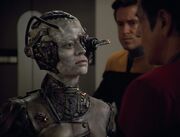
Seven of Nine speaks for the Collective
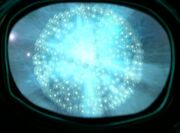
The Omega molecule
When Kathryn Janeway successfully negotiated a truce with the Borg and refused to discuss the terms via a neuro-transceiver , the Collective agreed to communicate via Seven of Nine. ( VOY : " Scorpion, Part II ")
The Borg Queen also spoke for the Collective, acting not as a mere liaison, but as a physical manifestation of the hive mind. The exact nature of her role is unclear. ( Star Trek: First Contact )
The Borg possessed a near-reverence for particle 010 , which they considered to be an expression of perfection. The Collective's fascination with assimilating this molecule has been compared to a religion. ( VOY : " The Omega Directive ")
Tactics [ ]
The Borg had a tendency to "scoop" all machine elements from a planet, leaving great rips in the surface where remaining sections of the road system suggested a city had once been. ( TNG : " The Neutral Zone ", " Q Who "; VOY : " Child's Play ")
The Borg were known to retrieve their own damaged technology, including nonfunctional Borg cubes. However, when a cube underwent submatrix collapse , the collective would immediately sever its link to the afflicted population, considering it dead. ( VOY : " Unity "; PIC : " Maps and Legends ")
Technology [ ]
Borg technology was a combination of technologies assimilated from other cultures, and technology developed within the Collective itself, in order to overcome obstacles to its goals. When confronted by a problem it could not solve with its existing resources and/or configuration, the entire Collective would work in concert to consider all possible solutions, and implement the one determined to be the most efficient. By applying the unique skills of each drone to a task, the hive mind could engineer new technologies and solutions at a pace that would astound an individual. ( TNG : " Q Who ", " The Best of Both Worlds, Part II ")
The Borg were usually exceedingly quick to adapt; their shields would often nullify nearly any energy weapon, and their weapons could usually penetrate nearly any shield or defense, within minutes. ( Star Trek: First Contact )
Spacecraft [ ]
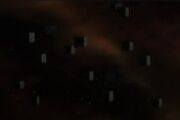
Borg cubes, arguably their most iconic ship design
Borg vessels were highly decentralized, with no distinct bridge , living quarters, or engineering section. Each ship was collectively operated by its complement of drones, under the general direction of the hive mind. Owing to the Collective's disregard for aesthetic considerations, the architecture of Borg ships took the form of basic shapes such as cubes and spheres and were made from a tritanium alloy. Borg ships were capable of regenerating from damage. ( TNG : " Q Who "; VOY : " Endgame ")
Each Borg spacecraft was equipped with a vinculum to interconnect its crew, which was in turn connected to a central plexus that linked the ship to the Collective. ( VOY : " Infinite Regress ", " Unimatrix Zero ") In addition to warp drive , vessels were fitted with transwarp coils that could achieve even greater speed by opening transwarp conduits . ( TNG : " Descent "; VOY : " Dark Frontier ") When critically damaged or otherwise compromised, a Borg ship would self-destruct to prevent outsiders from studying Borg technology. ( TNG : " The Best of Both Worlds, Part II ") In other situations, only the valuable technology would self-destruct, such as the case of the crew of Voyager's first attempt to steal a transwarp coil. USS Voyager encountered several damaged Borg vessels, notably including the cube carrying Icheb , Mezoti , Azan , and Rebi , and a sphere carrying a transwarp coil, which Voyager stole. ( VOY : " Collective ", " Dark Frontier ")
Infrastructure [ ]
Borg structures were located in deep space, in planetary systems, or on planets themselves. Each planet that the Borg modified showed a typical climate and assimilated infrastructure adapted from the previous inhabitants. ( Star Trek: First Contact ; VOY : " Dark Frontier ", " Dragon's Teeth ")
Their buildings consisted of simple shapes, similar to their geometrical ships, and rather than being single structures they were annexed together and added to when needed. By joining the new structures to existing ones, they would form a uniform complex. These buildings were gargantuan in scale, with structures so big that they could house Borg spheres which would dock inside. ( VOY : " Dark Frontier ")
The Borg also constructed structures that had specific functions, such as the transwarp hub . There were six such known hub locations in the galaxy that allowed Borg vessels to deploy rapidly to almost everywhere within it. These transwarp hubs had many structures for opening portals on them, and inside their corridors were interspatial manifolds which supported the transwarp conduits . Several of these manifolds that led to the Alpha quadrant were destroyed by Voyager via transphasic torpedos and collapse of the conduit itself on the vessel's return to the Alpha Quadrant . ( VOY : " Endgame ")
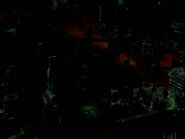
Appendices [ ]
See also [ ].
- Borg Collective
- Borg language
- Borg philosophy
- Borg spatial designations
- Borg species
- Borg species designations
- Borg starships
Appearances [ ]
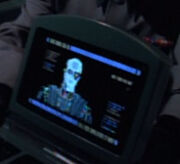
A Borg in the database of Voyager
- " The Best of Both Worlds "
- " The Best of Both Worlds, Part II "
- " Descent "
- " Descent, Part II "
- DS9 : " Emissary "
- Star Trek: First Contact
- " Blood Fever "
- " Scorpion "
- " Scorpion, Part II "
- " The Raven "
- " The Killing Game "
- " Living Witness "
- " Hope and Fear "
- " Infinite Regress "
- " Dark Frontier "
- " Survival Instinct "
- " Tinker Tenor Doctor Spy "
- " Collective "
- " Child's Play "
- " Unimatrix Zero "
- " Unimatrix Zero, Part II "
- " Imperfection "
- " Flesh and Blood "
- " Shattered "
- " Endgame "
- ENT : " Regeneration "
- " Remembrance "
- " Maps and Legends "
- " The Impossible Box "
- " Broken Pieces "
- " The Star Gazer "
- " Penance "
- " Assimilation "
- " Watcher "
- " Fly Me to the Moon "
- " Hide and Seek "
- " Farewell "
- " The Last Generation "
- " Envoys " (holograms)
- " Temporal Edict "
- " Crisis Point " (hologram)
- " I, Excretus " (holograms)
- " wej Duj "
- PRO : " Let Sleeping Borg Lie "
Background information [ ]
Concept and development [ ].
The conceptual genesis of the Borg, who were intended to replace the Ferengi as Star Trek: The Next Generation ' s main villains in its second season, was as a race of insectoids , an idea that would ultimately require modification due to the series' budgetary constraints. As Maurice Hurley explained in the March 1990 issue of Starlog (#152, p. 33): " What we really wanted to do, but couldn't because of money, was create a race of insects...insect mentality is great because it is relentless. The Borg are a variation of an insect mentality. They don't care. They have no mercy, no feelings toward you. They have their own imperative, their own agenda and that's it. If all of them die getting there, they don't care. We needed a villain who could make you dance, and the Borg could do it! "
Hurley made it a plot point in " The Neutral Zone " that Federation and Romulan starbases along the Romulan Neutral Zone had been mysteriously wiped out, having been "scooped off" the face of the planet in the same way that would later be referenced in " Q Who " and shown in " The Best of Both Worlds ". Intentions to lay more extensive groundwork for the Borg's introduction were frustrated by the Writer's Guild strike of 1988 . By the time of their first appearance in "Q Who", the species had been changed from insects to their more budget-friendly cyborg form. ( Captains' Logs: The Unauthorized Complete Trek Voyages , pp. 169 & 180)
The Star Trek Encyclopedia (3rd ed., p. 52) stated: " Writer Maurice Hurley derived the name Borg from the term cyborg (cybernetic organism), although it seems unlikely that a people living on the other side of the galaxy would know of the term. "
According to Michael and Denise Okuda in their Star Trek Chronology (2nd ed., p. 290), there had been plans to connect the parasitic beings from " Conspiracy " to the Borg, but these were ultimately abandoned: " At the time the episode was written, this was apparently intended to lead to the introduction of the Borg in Star Trek: The Next Generation' s second season. The Borg connection was dropped before 'Q Who?' (TNG) was written, and the truth about the parasites remains a mystery. " They also noted that, following production of the latter episode, it was "half jokingly speculated" by Gene Roddenberry that the machine planet encountered by Voyager 6 , leading to its transformation into V'ger , "might have been the Borg homeworld." ( Star Trek Chronology (2nd ed., p. 23))
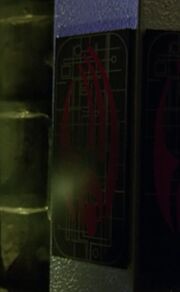
A Borg insignia
The Borg insignia, which first appeared in "Q Who", was described on its own Star Trek: The Next Generation - Inaugural Edition trading card (82-A) as " Resembling a great red claw over a background of circuitry, the symbol of the Borg is as mysterious as the race it represents. The Borg symbol may possibly define an amalgam of living tissue with computer circuits... " [2]
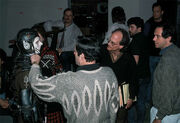
Westmore's Borg make-up is reviewed for "Q Who"
Michael Westmore revealed that the Borg actors were glued into their suits, and had to be unglued if they needed to use the bathroom. [3]
The idea for the sound of the Borg's multiple voices speaking in unison was thought up by sound editor Bill Wistrom and co-producer Merri Howard . After experimenting with different techniques, they discovered a way to lay multiple voices over one another and "make it sound like it was 8 million people," explained Wistrom. ( Star Trek: Communicator issue 147 , p. 32)
Chronologically, the first known in-universe appearance of the Borg to Humanity was in the 1996 motion picture Star Trek: First Contact , in which the Borg traveled back to the year 2063 to enslave the Human race. The writers of the Star Trek: Enterprise episode " Regeneration ", Michael Sussman and Phyllis Strong , stated, in the audio commentary on the ENT Season 2 DVD release, that it was their explicit intent to have the episode deal with the consequences of events depicted in Star Trek: First Contact , the Borg wreckage encountered in that episode being the debris of the Borg sphere destroyed by the Enterprise -E in that movie.
While it is not explicitly stated in "Q Who", Q implies that the sole focus of the Borg is on the technology of the USS Enterprise -D, and the Borg show no interest, in that episode, in the crew (although the segment of hull that the Borg remove from the ship apparently contained several crew members). By their next appearance, "The Best of Both Worlds", the Borg's objectives had changed to the assimilation of lifeforms, and this change of premise was referenced in dialogue. Subsequent episodes ignored the change in premise entirely.
Director Cliff Bole , who directed the "Best of Both Worlds" two-parter, thought highly of the Borg. He enthused, " The Borg are like Klingons. You can do anything you want with them. They're fun and a real expensive thing to play with. With them, you can do a big production value [...] The Borg allow you to have fun with the camera, the lighting and everything else. They challenge the imagination. " ("Cliff Bole – Of Redemption & Unification", The Official Star Trek: The Next Generation Magazine issue 17 , p. 31)
Through the course of Star Trek history, further retroactive continuity changes appear to have been made in respect of the Borg. As of "Q Who" and "The Best of Both Worlds", it appeared that Starfleet had never heard of the Borg. Subsequently, Star Trek: Voyager s " Dark Frontier " and Star Trek: Enterprise s " Regeneration " showed that not only was Starfleet previously aware of the existence of the Borg, Federation scientists actually pursued them – even if they were considered mere rumor. Further, although Guinan indicates in "Q Who" that her people were attacked by the Borg, it is implied that Starfleet was not aware of the threat. However, it was later revealed in Star Trek Generations that Starfleet, in fact, rescued the El-Aurian survivors of the Borg attack including Guinan, and it seems unlikely that Starfleet would not inquire as to the cause of their plight.
The existence of the Borg Queen was a controversial change made to the Borg during the writing of Star Trek: First Contact . While the writers had intended to stay true to the original concept of the Borg as a collective hive, they found it difficult to maintain the dramatic impact of villains without having a central face. Thus, they created the Queen. In the film, she claimed to have been present during the events of " The Best of Both Worlds ", which in retrospect would appear to have negated the reason for Picard's assimilation in that episode (it was claimed that the Borg needed a single representative to speak for them). While the Queen appeared to be killed at the climax of First Contact , she apparently survived unaffected by the Borg's next appearance in Voyager 's " Scorpion ". While many fans have attempted to reconcile this, there has never been an official explanation for her survival (save for an enigmatic comment by the Queen), and the appearance of relatively identical Borg Queens in later episodes. Some, though, have theorized that the Borg Collective contained many queens that served as focal points to different branches of their society. Still another explanation is that the Borg were in possession of innumerable copies of their Borg Queen, and that the superficial death of one version simply resulted in the activation of a similar version to take her place, in a similar fashion to the Vorta . The latter theory was corroborated by Rick Berman in an interview in Star Trek: Communicator . ( Star Trek: Communicator issue 121 )
Impact and legacy [ ]
The Borg were considered as an enemy for the Deep Space 9 crew (along with the Klingons , Cardassians , and the Romulans ) when Star Trek: Deep Space Nine was in development. Rick Berman later commented, " The Borg are not the kind of bad guys that are practical to use on a regular basis. " Whereas the Cardassians were eventually chosen for the main villain role, the Borg made no further appearances in Deep Space Nine after " Emissary ", although they were mentioned in episodes such as " The Storyteller ", " Playing God ", " The Search, Part I ", " The Way of the Warrior ", " For the Cause ", " Let He Who Is Without Sin... ", and " In Purgatory's Shadow ". ( Star Trek - Where No One Has Gone Before ) According to Robert Hewitt Wolfe in a tweet dated 28 January 2019, following the premiere of Star Trek: Voyager , a mandate was passed to the writing staffs of both Deep Space Nine and Voyager that the Borg (along with Q, following his single appearance on Deep Space Nine ) were only to be used on Voyager while Deep Space Nine retained creative control over the Alpha , Beta , and Gamma Quadrants , which Wolfe called "a fair trade." [4]
The Borg were considered by some commentators to be the greatest villains of Star Trek: The Next Generation . However, they were featured in only six episodes throughout its seven-year run. The creators have stated that this was due to the fact that the Borg were so powerful, and so it was not easy to come up with solutions for beating them. However, as time passed and future series went into production, the concept of the Borg evolved to include inherent flaws that could be exploited in many different ways – leading them to appearing in nineteen episodes of Star Trek: Voyager (although in only a fraction of these appearances were the Borg the primary villains; many episodes had them in supporting or otherwise non-antagonistic roles). This generous use caused many fans to complain that the Borg were being used too often on Voyager . TNG, DS9, and one-time VOY writer Ronald D. Moore once said of their perceived overuse, the Borg had been defeated so many times, that they had "lost their teeth." ( citation needed • edit )
Following "Regeneration" and the season it was in, ENT Season 2 , Brannon Braga stated, " We have no plans to see the Borg ever again. " ( Star Trek: Communicator issue 145 , p. 30)
In 2006 , the Borg were honored with their own DVD box set Star Trek: Fan Collective - Borg , featuring a number of their more memorable appearances in the Star Trek universe.
In an interview with StarTrek.com published on 1 April 2019, the actor Alan van Sprang , who played Leland in Star Trek: Discovery , echoed fan speculation regarding a potential connection between Control and the origins of the Borg: "I think it's very intriguing. When I first read the script I thought, 'Oh, is this the making of the Borg? Is that how it happens?' We're as much in the dark as anybody else, but as soon as I saw that, I thought, 'This is like The Borg.' The Next Generation' s Borg episode just blew my mind [when I watched it originally], let alone when Picard became Locutus . That's the first thing I thought of, which kind of tickled me to no end. 'Wow, I'm just going to milk this for all it’s worth.'" [5]
In an interview with TrekCore.com published on 19 April 2019, Michelle Paradise , then writer and co-executive producer of Discovery , clarified: "It's interesting — we weren't thinking Borg at all. I mean, we talked about all sorts of different things in the room, but there was never any intent on our part to parallel that in any way. I can certainly understand why people started to think we were going in that direction, but it was never where we intended to go with it." [6]
In an Instagram story dated 12 March 2020, Michael Chabon , then showrunner of Star Trek: Picard , opined of the same theory: "It has the virtue of making sense. But I don't think it's much fun." [7]
Apocrypha [ ]
The absence of the Borg from Deep Space Nine was explained in the novel The Siege , when a Borg cube tries to pass through the Bajoran wormhole and is destroyed by subspace compression; Sisko concludes that this event will cause the entire Collective to believe that the wormhole is unstable and would now avoid it.
In the alternate timeline seen in the Star Trek: Deep Space Nine book series Millennium , the Borg forged an alliance with the Federation to defeat Weyoun . The entire Borg Collective was destroyed along with the universe. This entire timeline was later reset thanks to Benjamin Sisko.
In an alternate timeline in the game Star Trek: Armada , the Borg succeed in conquering the Alpha Quadrant. Using a clone of Locutus, the Borg manage to assimilate Spock , kill Worf, and assimilate Earth. The timeline was reset thanks to Jean-Luc Picard and the crew of the Enterprise -E, who travel back in time with the aid of a ship from the future to prevent Spock's capture.
In the game Star Trek: Legacy , an alternate explanation was given to the creation of the Borg which states that the probe V'ger created the Collective to serve as its heralds in its search for knowledge. However, the creation of the Borg Queen resulted in the creation of an entity that abandoned the original intent of V'ger . This is also similar to the Shatnerverse version of events.
In the current volumes of the Next Generation Relaunch series of novels, the Borg have been driven to near extinction as a result of the Starship Voyager 's destruction of the Queen and the transwarp conduit network. However, they begin to reconstruct the Collective by building a massive cube in the Alpha Quadrant, in order to launch a vengeful new offensive against the Federation; their first strike results in the assimilation of Admiral Janeway and the destruction of Pluto before the Enterprise -E manages to destroy the cube with the original Doomsday Machine .
In Star Trek: Destiny a history of the Borg was presented. They were survivors of the Caeliar Gestalt and the crew of the Earth ship Columbia NX-02 thrown back in time and into the Delta Quadrant following an attack on a Caeliar city ship. The Caeliar forced the Humans into a perverted form of their Gestalt (a mental linking of the Caeliar) based upon the will of the last surviving Caeliar and not the whole. They launched a final attack of Federation space with over 7,000 cubes at their disposal; however, they were stopped after the Caeliar were made aware of their responsibility for the Borg's actions. The Collective was dismantled, and the assimilated Borg drones were accepted into the Caeliar's gestalt. Former drones fully regained their individuality (as evidenced by Seven of Nine's remaining implants dematerializing). This was followed up in the novel Full Circle . Q later noted that this timeline's invasion was provoked by Admiral Janeway's trip to the past in " Endgame ", reflecting that, if she had done nothing, the Borg would have eventually launched a massive assault on the Milky Way galaxy centuries in the future that would have completely assimilated all other life. The Voyager relaunch novel Unworthy explores the aftermath of the destruction of the Borg, including some Federation scientists trying to harness remaining Borg technology and Voyager encountering a vast fleet called the "Indign" consisting of species who actually wanted to be assimilated but were considered unworthy of that "honor" by the Borg.
In the Star Trek: The Original Series short story "The Trouble with Borg Tribbles" from the anthology book Strange New Worlds V , a Borg cube encountered a pod full of Tribbles which had traveled through a micro-wormhole from the Alpha Quadrant in early 2268 . This was the Borg's first contact with life from that part of the galaxy. The Borg assimilated the surviving Tribbles, only to find that their instinctive drive to eat and procreate was starting to overwhelm the hive mind, causing a widespread series of malfunctions.
The comic book series Star Trek: Countdown shows that Nero 's ship, the Narada , was enhanced with a mixture of Romulan and Borg technology. The sequel miniseries Star Trek: Nero has the Borg, the Narada and V'ger originating from an unknown civilization on the " machine planet " that was seen inside V'ger in Star Trek: The Motion Picture .
The Star Trek: The Manga story "Side Effects" in Shinsei Shinsei provided a different story to the creation of the Borg, with an experiment gone wrong to save a race through the daughter of one of the 1,000 or so survivors. Cybernetic implants, along with DNA from nine different species designed to keep a disease from spreading caused the girl to go insane and gain a twisted idea of saving her people. However, the intervention of Captain James T. Kirk made the situation even worse, as the laboratory where she was augmented collapsed and was sucked into a black hole . But an escape pod with the girl was launched, and apparently catapulted far into the past by the slingshot effect , where her cybernetic implants and DNA evolved to where she became the very first Borg Queen.
In the game Star Trek Online , the Borg have resurfaced after thirty years and have conquered several Federation sectors, including the Mutara sector . The Borg of 2409 look much more like zombies, with some of their cybernetic implants looking like bones coming out of their bodies.
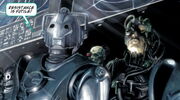
The Cybermen and the Borg
The comic book crossover series Star Trek: The Next Generation - Doctor Who: Assimilation² involves a plotline in which the Cybermen of the Doctor Who universe alter time and space in order to form an alliance with the Borg. The united cyborg force proves to be a devastating threat to the Federation, but the two races end up turning against each other, with the Cybermen going to war with the Borg and forcing the crew of the Enterprise -D and the Eleventh Doctor and his companions to ally with the Borg to restore the Collective and vanquish the Cybermen. At the end of the series, the Borg start to investigate time travel in order to find a way to assimilate the Doctor.
In The Delta Anomaly , a book set in the alternate reality created by the Romulan Nero 's attack on the USS Kelvin , the serial killer known as The Doctor ( β ) is suggested to be related to the Borg. This therefore establishes an earlier contact with Earth than in the prime reality.
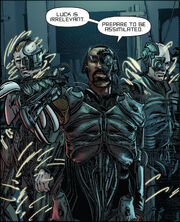
The Borg of the alternate reality
In Star Trek: Boldly Go , a comic series also set in the alternate reality and after the events of Star Trek Beyond , the Borg make an appearance as the villain in the first arc of the series, seeking the Narada due to their awareness of its ties to the Borg. They attempt to assimilate Spock , but the primitive assimilation of this era is unable to cope with his hybrid DNA. The shock of his escape and the retrieval of other near-assimilated officers enables the Federation and the Romulans to destroy the Borg.
External links [ ]
- Borg at Memory Beta , the wiki for licensed Star Trek works
- Borg at Wikipedia
- 1 Abdullah bin al-Hussein
- 3 John Paul Lona
The History of the Borg - Star Trek's Unstoppable Villains
From The Next Generation to Picard Season 3, the Borg are Star Trek's most insidious villains - born from equally epic behind-the-scenes battles.
Many of Star Trek 's most iconic species can be traced back to series creator Gene Roddenberry. However, the iconic and unstoppable Borg are the brainchild of one of his greatest on-set adversaries. Maurice Hurley was a new arrival on The Next Generation' s staff who didn’t see the future the same way Roddenberry did, but was bound to tell stories by his rules. Their conflict gave rise to characters who would help define the entire franchise.
When Roddenberry staffed The Next Generation , he brought many of the writers he worked with on The Original Series back. However, there was a new narrative edict. Starfleet in the 24th Century would've continued to evolve from Captain Kirk's era. He believed there would be no jealousy, tension or any interpersonal conflict within the crew. Roddenberry's lawyer Leonard Maizlish started acting as a de facto producer, allegedly responsible for hiring Hurley to enforce Roddenberry's strict rules. Yet the talented storyteller just didn't know what to do with no crime, conflict or any of the other storytelling staples he was used to from procedurals like Miami Vice and The Equalizer . In order to alleviate this problem in the second season, Hurley wanted to introduce a new kind of villain that couldn't be reasoned with or stopped.
RELATED: Star Trek: How Picard's Assimilation by the Borg Radically Changed the Franchise

Star Trek's Borg Were Originally Going to Be Insects
The central problem between Roddenberry and Hurley was that the latter didn't believe in what he was supposed to sell the other writers. In the documentary Chaos on the Bridge , Hurley called Roddenberry's ideas of the future "wacky doodle." Since he thought they were bad rules, he could only guide them in constructing "bad" episodes. Sometimes writers would even pull an end run and take a story to Roddenberry that bent or broke his rules. Hurley claimed he would "go ballistic" arguing Roddenberry's ideas back at him. Still, he wasn't setting out to make bad Star Trek , so he thought of a solution: insects.
The Ferengi were introduced in Season 1 as the "new Klingons," but they failed to land in that way with the audience. Hurley thought of insects as an unrelenting natural force, and believed that would make a good basis for an alien species to menace the crew all season. Insects proved to be impossible to create on a regular basis, so he instead went with the idea of cybernetic and organic lifeforms -- cyborgs. He dropped the "cy" from the name, and The Next Generation had its most memorable villains. Hurley planned to seed Season 2 with hints to the Borg until revealing them during October sweeps for the first time. However, the 1988 Writers Guild of America strike necessitated a new plan.
Eventually, Hurley used the popular character of Q to bring the Borg into contact with the Enterprise -D in The Next Generation Season 2, Episode 16, "Q Who?". However, they became a looming threat out in the galaxy rather than a regular villain, as the costuming for the Borg proved to be as difficult as crafting believable insects. Hurley envisioned the aliens being mostly disinterested in organic life, only concerned with Starfleet technology. This changed when the villains returned to assimilate Captain Jean-Luc Picard at the end of Season 3. By that time, Hurley had happily moved on from Star Trek .
RELATED: How Seven of Nine Was Rescued From the Borg on Star Trek: Voyager
The Borg Have Become Star Trek's Most Important Villain
Captain Picard and the Enterprise -D crew faced the Borg only nine times in 35 years, including in the film Star Trek: First Contac t and Picard Season 3. However, the Borg appeared in a whopping 23 episodes of Star Trek: Voyager -- in large part because of Seven of Nine, the former Borg turned Starfleet officer. The writers who succeeded Hurley worried that using the Borg too much would've curtailed their threat. Some fans did complain about the prevalence of the Borg in Voyager . Yet that allowed the Admiral Janeway from an alternate future to hobble the Borg Collective in Voyager 's series finale.
The Borg were mostly a thing of the past by the time Picard debuted, with a significant portion of the first season taking place on a "dead" Borg cube. By Season 2, the introduction of a new Borg Queen meant Picard had to again face a mini-collective. However, by then showrunner Terry Matalas and his crew of storytellers knew how to make Roddenberry's rules work. Hurley's unstoppable, unrelenting villains became provisional members of the Federation. Their collective was opt-in only, and their purpose was to stand by a tear in space-time that some future threat would emerge from. Picard could apparently negotiate peace with anyone.
Well, maybe not anyone . The Borg also made him and his son Jack Crusher time bomb for their last-ditch attack on Earth. When Picard faced the Borg Queen in the Picard series finale , he wasn't there to talk. The Borg were seemingly destroyed once and for all by the crew of the Enterprise -D. But Maurice Hurley's creations are too perfect to stay gone. He may not have known how to shape a season of Star Trek , but he inspired its most fascinating and enduring villain because of his frustration.
- More to Explore
- Series & Movies
Published Apr 24, 2017
Star Trek 101: The Borg
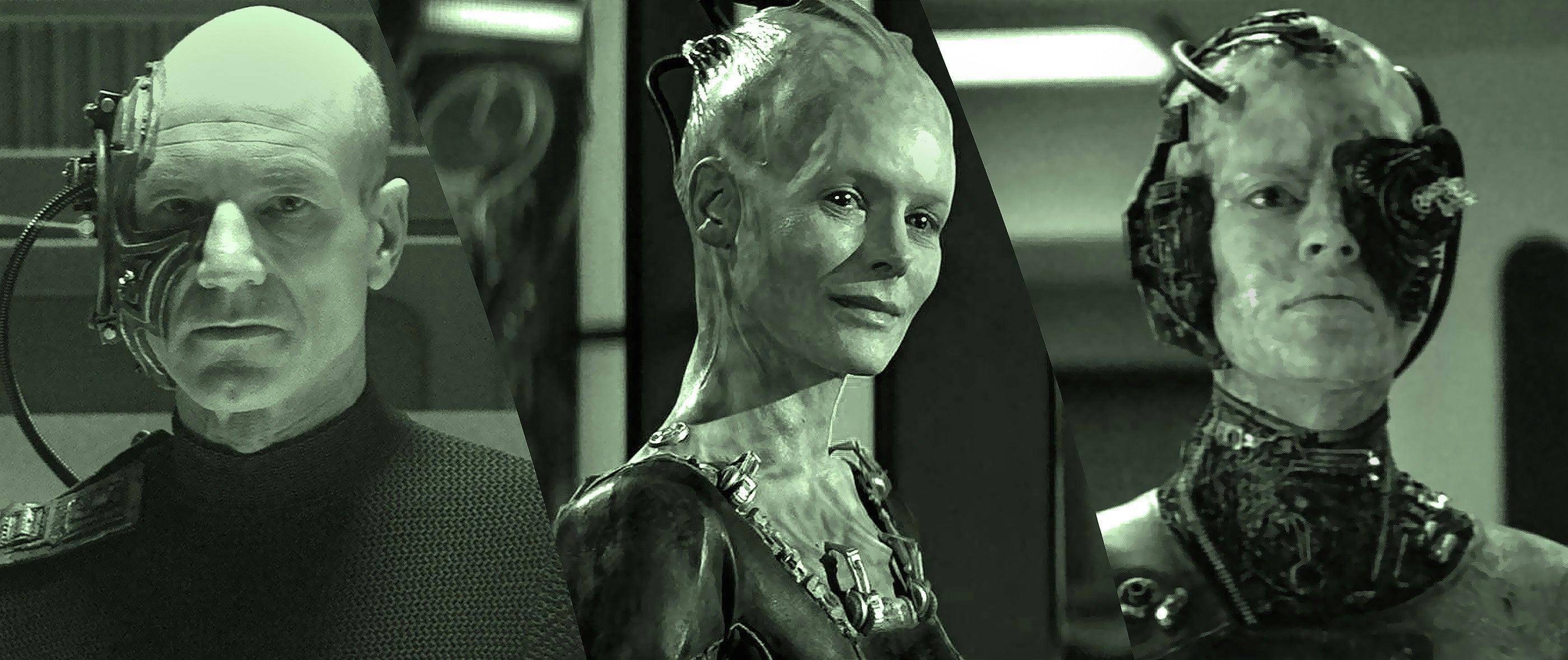
Star Trek 101, StarTrek.com 's newest regular column, serves two functions: succinctly introduce Star Trek newcomers to the basic foundations and elements of the franchise and refresh the memories of longtime Trek fans. We're pulling our entries from the book Star Trek 101: A Practical Guide to Who, What, Where, And Why , written by Terry J. Erdmann & Paula M. Block and published in 2008 by Pocket Books. An invaluable resource, it encompasses The Original Series , The Animated Series , The Next Generation , Deep Space Nine , Voyager and Enterprise , as well as the first 10 Trek feature films. Today, we learn about the Borg...
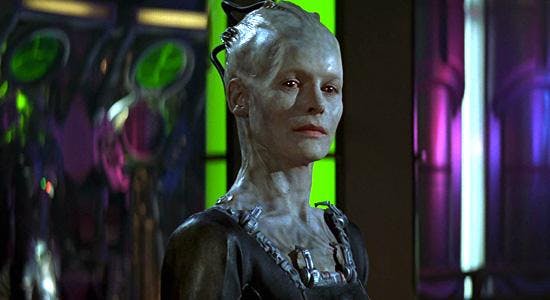
The Borg collective is an amalgamated group of many subjugated races: human, Klingon, Vulcan – you name it. The Collective assimilates every sentient being it encounters, improving the individual by removing “imperfect” organic body parts and replacing them with technologically superior artificial ones – such as eyes that emit laser beams and hands that double as buzz saws.
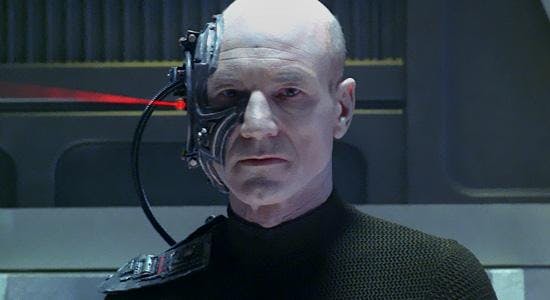
What the Collective lacks in free will, it makes up for in wholehearted dedication. All members dress the same (basic black, with complementary circuitry and tubing)., act the same (zombie-like), and spout the same party line: “You will be assimilated” and “Resistance is futile.”
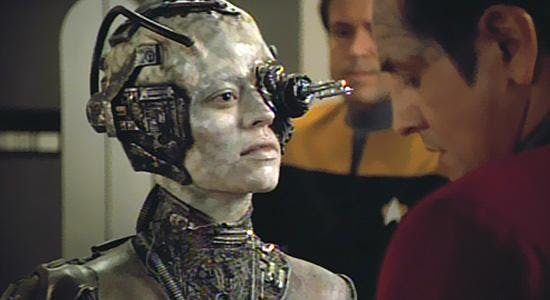
Their most common form of transportation is the gigantic and deadly Borg cube, armed with powerful energy weapons and capable of self-repairing damage almost immediately.
Paula M. Block and Terry J. Erdmann are coauthors of numerous books about the entertainment industry, including Star Trek 101; Star Trek Costumes: Fifty Years of Fashion from the Final Frontier; Star Trek: The Original Series 365; and Star Trek: Deep Space Nine Companion . They currently are writing the latest in their series of Ferengi novellas, which (so far) includes Lust’s Latinum Lost (and Found); and Rules of Accusation . Their most recent non- Star Trek book is Labyrinth: The Ultimate Visual History.
Get Updates By Email
- Star Trek 101

A Complete Timeline of the Borg in Star Trek
Quick links, the creation of the borg through star trek: enterprise, star trek: the next generation is when starfleet engaged the borg, star trek: voyager traveled through borg space and almost destroyed them, the borg returned in star trek: picard for one last battle.
Throughout the six-decade history of Star Trek , there have been many iconic villains, but perhaps none more so than the Borg. Created by Maurice Hurley, the head writer for Star Trek: The Next Generation Season 2, the Borg began as an organic species looking attain perfection. They achieved this by merging their organic bodies with cybernetic components. Individuality was erased, creating a hivemind culture of beings that sought only to assimilate more species and their technology in the search for perfection. They are led by a queen, a singular consciousness that can occupy multiple bodies.
The Borg are incredibly powerful and are known to travel via transwarp. They are even capable of time travel, though they don't do it very often. Given all that the Borg have going for them, it's no surprise that they were meant to be the ultimate villains Starfleet could never reason with. Over time, these villains became more complex and some even became Federation allies. Yet, the Borg have a long history in the Star Trek timeline, predating the earliest human space travel.
How Did Star Trek: Enterprise Become a TV Series?
The Borg have existed in their modern form since at least the time of the 15th Century on Earth. During the USS Voyager's travels in the Delta Quadrant, they met members of the Vaduwaur species who had been in stasis for more than 900 years. They had "many encounters" with the Borg who, by this time, had assimilated a few star systems in the Delta Quadrant. However, given the Vaduwaur didn't see them as their worst nemesis, they weren't as advanced as the Borg in the 24th Century.
In 2063, a Borg Sphere emerged from a temporal rift to prevent the Humans from making first contact with the Vulcans. The USS Enterprise-E followed them and destroyed the sphere, though a number of drones beamed aboard their vessel. Captain Picard defeated them, and Zefram Cochrane made his first warp flight . Some 90 years later, in Star Trek: Enterprise , remnants of the sphere were found in the North Pole. A handful of drones were revived and escaped in a space vessel. They were pursued and destroyed by the NX-01 Enterprise, but not before sending a message about Earth's location to the collective in the Delta Quadrant.
10 Star Trek Time Travel Stories That Changed Canon
The El-Aurian Guinan was saved by the USS Enterprise-B in 2293, along with fellow survivors of her people. Her planet had been assimilated by the Borg, and this was when Starfleet learned the species' name. Erin and Magnus Hansen, tried to study them in the late 2340s before they and their daughter Annika, Seven of Nine, were assimilated. In The Next Generation Season 2's "Q Who," the omnipotent being sent the USS Enterprise-D thousands of lightyears away from Federation space where it encountered a Borg Cube. They were only concerned about technology at the time, but this meeting led them to Federation space.
One year later, in 2366, the Borg sent a single cube to assimilate Earth. They captured Captain Jean-Luc Picard and assimilated him, giving him the name "Locutus." He was meant to demoralized Starfleet to prevent humans and the rest of the Federation from fighting back. He was freed of their control, but not before the Battle of Wolf 359 which destroyed 39 ships and killed 11,000 people. Among those were the wife of Commander Benjamin Sisko and the crew of the USS Constance of which Captain Liam Shaw was one of ten survivors. Commander Data briefly connected himself to the collective, ordering the Borg drones to enter regeneration and initiating the self-destruct sequence.
In 2368, the USS Enterprise-D encountered the Borg again, discovering a crashed scout ship. The drone Third of Five survived . Picard wanted to use the drone to implant a deadly virus into the collective. However, separated from the collective, the drone became an individual named "Hugh." He was returned unchanged to the collective, though Hugh's individuality caused a meltdown in the collective. A year later, Data's brother Lore found the cube and became their leader. He tried to replace their organic minds with positronic brains like his. The rogue Borg eventually overthrew him with help from the Enterprise. Five years later, another Borg cube was sent to Earth and was eventually destroyed, but not before sending the Sphere holding the Queen back to 2063.
How Did Star Trek: Voyager Become a TV Series?
In 2373, the USS Voyager entered Borg space on their journey home from the Delta Quadrant. At the same time, the Borg tried to assimilate Species 8472, which hailed from a dimension of "fluidic space." The assimilation didn't work and war broke out. Because 8472 was so hostile, Captain Janeway was able to enter into an alliance with the Borg to help defeat them, specifically with the help of the ship's holographic Doctor. The Borg betrayed them, which Janeway anticipated. The drone Seven of Nine was freed from the collective and became a member of the crew. Though she wished to rejoin the collective and tried to do so twice, she eventually chose to stay with Voyager .
In 2375, a transporter accident involving the Doctor's mobile emitter (based on 29th Century technology) and Seven of Nine's Borg nanoprobes. A drone was "grown" in the tank and designated One. The Borg tried to assimilate him and he willingly ended his own life. Later that year, the USS Voyager salvaged a transwarp coil from a destroyed Borg vessel. This led the Borg to enact a trap meant to bring Seven of Nine back into the collective as a replacement for Locutus. Janeway and the crew rescued her. A year later, while trading with the Brunali, Voyager was attacked by Borg vessel. However, they hid a photon torpedo in a captured Brunali vessel that destroyed the Borg ship, allowing Voyager to escape.
In 2377, Seven of Nine was reunited with other Borg in "Unimatrix Zero," a digital plane where drones retained their individuality. Captain Janeway used this opportunity to plan an attack on the collective and start a resistance movement. Captured by the Borg, many of Voyager's crew were assimilated. Thanks to the Doctor, they retained their individuality freeing thousands of drones and starting a Borg civil war. In 2378, a time-traveling Admiral Janeway showed up on Voyager with a plan to get the ship home. The plan succeeded, but the Admiral was assimilated. She carried a virus that decimated the collective to nearly the point of destruction. Five years after the return of the USS Voyager, the rag-tag crew of the USS Protostar found a Borg Cube, but they let sleeping Borg lie .
The Picard Blu-ray Underscores Why Each Season Needed the Borg
A Borg Cube that assimilated a Romulan vessel suffered a submatrix collapse, and it was captured by the Romulan Star Empire. In 2399, the ex-Borg Hugh led the Borg Reclamation Project on a ship dubbed "the Artifact." To stop a plan by a cult of anti-synthetic Romulans in the Tal Shiar, Seven of Nine created her own mini-collective and led the Artifact to crash on a planet populated by synthetics. It's presumed the surviving xBs (as they were called) joined the society on that planet. Hugh, however, was killed in the attempt.
In 2401, a Borg vessel of unknown origin appeared and asked to speak with Admiral Jen-Luc Picard. The Queen of this collective was Agnes Jurati, who was assimilated by the Borg Queen of an alternate timeline who took Picard and his allies into the past to save the future they knew. Jurati convinced the Queen to create a new kind of collective in which individuality was maintained and assimilation was voluntary. This new collective applied for provisional Federation membership to stand guard at a rift in space through which a still-unknown threat would emerge.
Also that year, the near-dying Borg Queen allied with Changeling terrorists angry with the Federation after the Dominion War. They infiltrated Starfleet, adding a DNA sequence to Starfleet transporters that would assimilate anyone under the age of 25 once they received a coded message. That message was sent by Jack Crusher , the son of Picard and Dr. Beverly Crusher. He was assimilated by the dying Borg Queen and named Võx. New technology added to modern Starfleet vessels allowed these new Borg to assimilate the ships in moments. Using a rebuilt USS Enterprise-D, the command crew of that vessel saved Jack and destroyed the remaining Borg, seemingly defeating them once and for all.
The Star Trek universe encompasses multiple series, each offering a unique lens through which to experience the wonders and perils of space travel. Join Captain Kirk and his crew on the Original Series' voyages of discovery, encounter the utopian vision of the Federation in The Next Generation, or delve into the darker corners of galactic politics in Deep Space Nine. No matter your preference, there's a Star Trek adventure waiting to ignite your imagination.
Created by Gene Roddenberry
First Film Star Trek: The Motion Picture
Latest Film Star Trek: Nemesis
First TV Show Star Trek: The Original Series
Latest TV Show Star Trek: Strange New Worlds
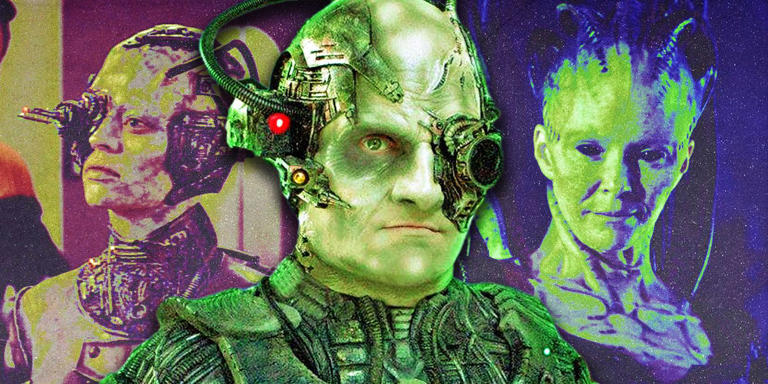

Creating the Borg

“Q Who?” turned out to be one of the most influential episodes of Star Trek: The Next Generation . It introduced some of the nastiest villains in science fiction: the Borg.
Derived from the word “cyborg,” the Borg were meant to give The Next Generation what the Ferengi could not : a deadly, remorseless enemy.
Their presence had been hinted at in the final episode of Season 1, “The Neutral Zone”, and later revelations in the series suggested they were responsible for the disappearance of Romulan outposts mentioned at the time.
Budget restraints prevented the Borg from being depicted as insectoids, which is what Maurice Hurley, the writer of “Q Who?”, originally had in mind. But the hive concept he introduced survived to become the Borg Collective.
In addition, the Borg’s unique cube-shaped ship and their eerie appearance — reminiscent of the biomechanism designs of Hans Ruedi Giger and the cybernetic, laser-eyed Lord Dread from the 1987 series Captain Power and the Soldiers of the Future — all contributed to the Borg ascending to the heights of Star Trek villainy, exactly as Hurley had intended.
Something unique
Designing the first Borg costumes presented Star Trek ’s resident costume designer, Durinda Rice Wood, with a challenge: these half-machine, half-human creatures were supposed to look like nothing the TV viewer had seen before.
“They said to me, ‘This is going to be the new bad guy of the universe’,” she recalled years later.
They wanted a new bad guy and they wanted it to be a cyborg. They wanted something that was cold and like an automaton, they all kind of looked alike and they didn’t have emotions. That’s what was going to be the scary thing about it. I was tired of the futuristic, clean, stainless steel imagery of the time. I was interested in more texture, the ugliness of humanity and the ugliness of nature. The idea was always that they would be half-human and half-mechanical. Their body parts would wear out and they would replace them with mechanical parts, so I wanted to make all of the mechanical parts different and unique for each person, thinking that their parts would wear out at different times. You know, when you get older one hip goes and that gets replaced and it happens differently for everyone.
Wood’s first designs were inspired by a Giger drawing, who had worked on the Alien movie.
One idea was to integrate the Borg’s face with the body, but time restraints made it hard to pull off:
I wanted it to melt into the costume more, but they wanted the face to be bright white. The thing is, we couldn’t do it. We just couldn’t do it in a week — we could have done it in three weeks. For something that the world has never seen before, you need time to develop it and invent it!
Wood came up with the idea of running tubes connecting different parts of the Borg costume. This helped to make clear each drone was unique.
I wanted each one to be different. There were certain parts that were totally anatomical and then there would be a real leg that needed to have the tube.
She also planned to give the Borg a complex color scheme that mixed different shades of black to create a dark, distinctly organic look.
I wanted them to be a little bit more greeny black. In fact, in the first rendition of them, the skin underneath was a dark, dark greeny black and the parts on top were black. So overall there would be a feeling of inky, greeny black — a sort of a sewer black. I didn’t want it to be regular black.
The realities of television production intervened and the finished drones were a uniform color. The Borg only acquired more complex colors in Star Trek: First Contact , which had the advantage of a feature film budget.
Androgynous drones
The producers originally intended the Borg to be without recognizable genders.
We were trying to make them androgynous. I remember somebody — I think it was Rick [Berman] — saying they shouldn’t be totally male or female. That was part of the scariness of them; you couldn’t work out whether they were male or female.
In the end, nearly all the Borg actors were male, but one of Wood’s early drawings shows a female drone, years before viewers were introduced to Seven of Nine and the Borg Queen.

Improvements
Because the Borg combined costumes, makeup and props, Illustrator Rick Sternbach was asked to give his input.
He recalled that his sketches were a little different from Wood’s:
My drawings had a number of implants and some kind of a suit for the actor to wear. My early take on the color was more of a silvery gray.
The next person to weigh in would be Robert Blackman, who replaced Wood as costume chief in Season 3.

The Borg outfits remained pretty much the same for “The Best of Both Worlds” but were reworked for “I, Borg.”
That was a conscious effort to make them look less like jumpsuits with things applied to them and more like full bodysuits. They were brilliantly created by Durinda in such a short amount of time, but I felt that we had used them over and over again and eventually you think, […] there’s too much space in between all of the stuff. The connecting tissue was more dominant than the actual object, so I just visually reduced it and we tried to butt as much stuff up against each other as we could and still have the actors move. Then eventually I think Rick [Berman] and I came up with this together — we repainted them so that they were a little bit more rusty, a little bit less perfect.
Michael Westmore explained how the Borg’s makeup evolved:
The idea was that the Borg were almost drained of their blood. If we had them the same color as a human, they wouldn’t be as scary, so their skin went very pale and we shadowed them.

The original headpieces Westmore created were relatively simple affairs that featured the tubing Wood had designed for the costumes.
They wanted to keep the makeup down, because they had all the dressing to go through, so the heads in the very beginning were like helmets with a lot of tubing running around them.
When Patrick Stewart was assimilated into the Collective and became Locutus of Borg, a more sophisticated look was required.
My son Michael, who did all the Borg electronics in the eyes and the head, found this little laser that was only one inch long. We mounted it on Patrick Stewart as Locutus. There’s that scene at the end of the first part of “The Best of Both Worlds” where Patrick turns his head and looks directly into the camera with his laser. We had no idea what was going to happen. Boy, the phone rang! Rick [Bermanj saw it and said, “Oh, my God, what a great effect!”
More elaborate
For Star Trek: First Contact , Production Designer Herman Zimmerman had hired Ricardo Delgado, who had previously worked on Deep Space Nine , to come up with Borg concepts.

Delgado was only able to provide a few ideas before being hired by Disney. The task of creating a look for the sinister yet seductive Borg Queen fell to Debra Everton, who, together with Gina Flanagan, did all the costumes for First Contact , except the new Starfleet uniforms.
She recalled she came up with a similar silhouette to the old Borg, “but much more elaborate for a feature’s scope.”
I wanted it to look like they were Borgified from the inside out rather than outside in. It was tricky to get the layers and the depth into the costumes, so it would look like the piping and the tuving were coming out of them. We collaborated on the headpieces with Michael Westmore. I’m really happy with them. And when you see them all lit and in their element, they’re very creepy.

Makeup was still Westmore’s department. Berman had told him, “This is our chance to see the Borg the way we’ve always wanted them to do them.” That meant a lot more detail. It had taken an average of two hours to apply the Borg makeup for television. For the movie, that became five hours.
The first thing that changed was the helmet. Supposedly that’s where the Borg’s biomechanical components make their connection with the body. Berman wanted to see that connection revealed.
Instead of having an entire helmet, now we have these individual pieces that are on the head, so you get this bald look. That way the pieces look like they’re clamped into the head individually, instead of being a full cap that pulls over the top.
The film also marked a long overdue first for the Borg. Whereas previous drones were all assimilated humans or human-like species, Star Trek showed fans assimilated Bolians, Klingons and Vulcans.
“One day for the fun of it, when I came in they had thrown some Bajoran noses on some Borg,” said Westmore, “so we had some Bajoran Borg.
Then near the end, I asked Rick about letting me do a Cardassian Borg. You have to look quick for him, because he only worked two or three days.
Star Trek: What Are The Origins of the Borg?
What is the mysterious backstory of the Borg, and what made them the nefarious villains they are?
Wild and wonderful creations have stemmed from the Star Trek franchise over the years, from the plethora of real world influencing technology , to a rich and diverse socio-political infrastructure. However, some of the most interesting aspects of this world's stories are the villains. These are often not the run-of-the-mill villains; rather, they are rich and complex cultures or beings that have relatable backstories, from the memorable Khan to Dul Dukat. They are not just evil, but rather warped and transformed through years of pain or necessity. The Klingons, the villains of the Original Series, are prime examples of this. They began as wild, animal-like antagonists, only to later join the Federation and become not just understandable and relatable, but creating one of the most beloved characters in the entire franchise: Worf. One of the biggest villains however, the Borg, is shrouded in a thick veil of mystery, their origins never fully explored.
This enigma of where they came from makes them all the more scary. Up until the questionable introduction of the powerful Borg queen in Star Trek: First Contact, they appeared to be akin to a computer virus. They were not necessarily good or bad; they just followed the most logical route to achieve perfection, without fully understanding the consequences of their actions. The queen and her distinctiveness skewed this slightly, giving them a much more nefarious persona. Regardless of whether this was a good choice or not, they still never, despite the film featuring them as the main antagonists, fully fleshed out their origin story.
RELATED: Star Trek: Who Would Win, The Borg Or The Dominion?
Not only does the film not do this, but there is very little information to be found within canon. The biggest answers come from outside the official universe, usually from the books. Specifically, the Destiny trilogy of books by David Mack opens up an entirely new and exciting series of post- Nemesis storytelling. There is a lot of content and buildup to the Borg origin story , spanning books such as R esistance, Before Dishonor, and Greater Than the Sun. However, it pretty much starts with the Starfleet ship the Columbia being attacked by Romulans. The ship is heavily damaged, with their warp drive and long range communications offline, with no method of repair. Desperate, they crawl their way to a nearby star system and are greeted by a race of beings called the Caeliar.
The Caeliar are a reclusive race of highly advanced beings, who are suggested heavily to be some of the first sentient beings into the galaxy. They surpass anything the Federation has ever experienced before. Each and every member of their society is effectively immortal, having altered their biology to the point where their bodies are made out of something called catoms. The catoms are a form of programmable matter, similar to nanotechnology but far more advanced. This tech allows each member of their race to join together in an advanced hive mind, but one where they are still able to keep their own individual consciousness. They do this not only to power themselves and keep their bodies from deteriorating, but they have also found a way to harness omega particles, the very same particles the Borg are repeatedly obsessed with obtaining — a little foreshadowing going on here.
A lot more happens in the book, but the next most notable event is the accidental supernova of their home star. The city quickly evacuates, beginning calculations to escape using subspace corridors, as these beings have evolved far past the need for primitive warp drives . The Caeliar, being the good people they were, considered the safety of the crew of the Columbia to be paramount, and thus sent the ships containing the Starfleet officers first. In their rush to save them, however, they did this before the calculations were complete, and the ships were scattered across various different points in space and time. One of these ships, heavily damaged by the subspace corridor, crash-landed on a planet in the Delta quadrant, a few thousand years earlier.
Most perished during the crash, with only a few Caeliar and Starfleet officers surviving. The Caeliar found themselves in a tricky situation. Unable to generate the omega particles that powered the catoms they were made of, it would only be a matter of time until they died. Taking it in turns, one Caeliar after the other chooses to sacrifice themselves to give the remaining Caeliar an influx of catoms, until eventually there remained just one. Damaged and on the brink of death, the last of them became desperate, and approached the three surviving Starfleet crew members to broker a deal. She proposed that they merge together, harnessing their biological processes in order to power her catoms, and in return she would share all the knowledge she had, joining together as one hive mind. The officers refused, but in a desperate act of someone on the brink of death, she overpowered them. Thus, the first three Borg drones were formed.
Upon merging together, and forming the first stages of a primitive Borg collective, she does what the Borg do best and evaluates the minds of those she has assimilated . She decides that the scientist and engineer are the most useful to her, and that the poor tactical officer is expendable. She then orders her two drones to kill and consume their once friend in order for them to survive, and continue powering her catoms. They eventually come across others, natives to the planet, and assimilate them too, the first of many species to become victims of the Borg.
While this is all unofficial backstory for the Borg, it’s the best that can be provided with the little information audiences get through the main series of TV shows and movies. It seems that writers are afraid of giving the Borg any official origin story, fearful that anything they write might tarnish or take away from the fantastic villain they have in front of them. The mystery of the Borg is something that can be seemingly mined forever, as even the first and second seasons of Picard show . This said, the story given to readers by David Mack does justice to the Borg. It shows almost heartbreakingly how such an advanced civilization of morally good people can be broken, through fear as desperation, into becoming some of the most feared beings in science fiction history.
MORE: Star Trek: The Problem With The Federation’s Economy
Star Trek: Discovery’s Elias Toufexis Addresses Fans Comparing Eve Harlow’s Moll To Ahsoka’s Shin Hati, And He Didn't Hold Back
He wanted to make one thing clear.
Star Trek: Discovery 's final season has been rolling strong with an action-packed season on the 2024 TV schedule as the crew continues to track the two couriers who keep finding clues to the Progenitors' artifact. Fans with a Paramount+ subscription seem to love the Bonnie and Clyde dynamic of L'ak and Moll, and some have even likened the latter to Ahsoka 's Shin Hati. I asked actress Eve Harlow about it, but Elias Toufexis popped in and had to give his strong response to those likening the two.
It's not necessarily surprising Moll and Shin Hati are compared, seeing as they're both sci-fi villains with blonde hair and prominent eye shadow. With that said, the comparison stops there, and L'ak actor Elias Toufexis wanted CinemaBlend to spread the word that in no way did Star Trek: Discovery copy Ahsoka. Here's what he had to say:
Can I say something because this has been bothering me so much? I am online a lot. So [Ahsoka] came out in August of 2023. We started shooting this in May of 2022. I'm not gonna be on Twitter like, ‘Dude, shut up’. But please put that out there because that bugs the hell out of me.
Ahsoka might've released before we had Star Trek: Discovery Season 5, but both shows began production at the same time. Disney+ confirmed on social media that the Star Wars show's shoot kicked off in May 2022, and it's fair to say neither show had any idea what the other had planned. That said, if we suddenly hear about an upcoming Star Trek show that features short stories similar to Star Wars: Tales of the Empire , I might get suspicious. I also wouldn't complain because I'd love to see what the Borg do when they aren't being thwarted by Starfleet.
Eve Harlow added that she generally doesn't look at fan reactions to her performances these days, but did have some insight to share on Moll's blonde hair and short cut. She talked about how she might've inspired the decision and added her thoughts about the situation just based on our conversation:
I will say, the blonde thing, I actually auditioned for the show [wearing a wig]. I'm into wearing wigs in my own life., I think it's really fun. I have an array of all different colors, and I auditioned for Moll with like a pixie silver wig because I just felt that it was very sci-fi, and I put on fun makeup. And actually, I don't watch Star Wars and so that was like my own thing. I mean, look, we can go back to Blade Runner, right? That cut I think has been around for a while in the sci-fi kind of realm.
Star Trek: Discovery fans may mean well or make the comparisons in jest, but before anyone takes it too seriously, let it be known now that there is no real link between Moll and Ahsoka 's Shin Hati beyond the fact that they're both badass women. That said, Star Trek has a legacy of strong and inspiring female characters like Michael Burnham and more.
As Discovery's final season rolls on over on Paramount+, we're slowly learning more about what the future of Star Trek looks like after its end. Alex Kurtzman told CinemaBlend future series of a hundred episodes and more are "unlikely," and weeks later, we saw evidence of that when Lower Decks was canceled . Fortunately, we're told surprises are on the way , so hopefully there will be a new show announced to replace it before too long.
Until that time comes, continue to tune in for new episodes of Star Trek: Discovery on Paramount+ on Thursdays. I can't wait to see how the series ends, and whether L'ak and Moll can continue to evade Discovery or if Michael and the crew will eventually catch up to her.
CINEMABLEND NEWSLETTER
Your Daily Blend of Entertainment News
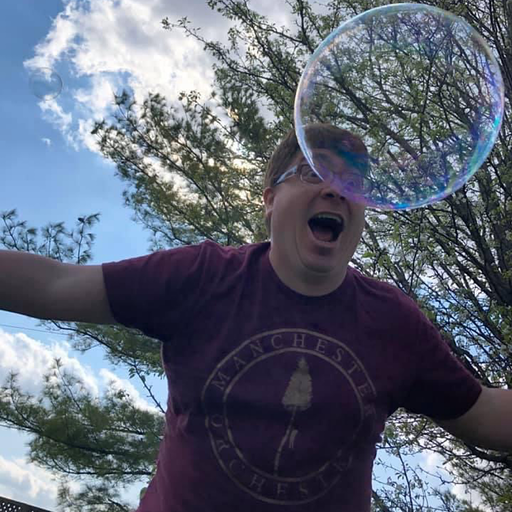
Mick Joest is a Content Producer for CinemaBlend with his hand in an eclectic mix of television goodness. Star Trek is his main jam, but he also regularly reports on happenings in the world of Star Trek, WWE, Doctor Who, 90 Day Fiancé, Quantum Leap, and Big Brother. He graduated from the University of Southern Indiana with a degree in Journalism and a minor in Radio and Television. He's great at hosting panels and appearing on podcasts if given the chance as well.
X-Men ’97’s Newest Episode Featured A Great Storm Twist, And The Director Told Us Why It’s ‘Nice Having Ownership Over That Story’
I Asked The Conners Bosses Why Roseanne Fave Martin Mull Hasn’t Returned As Leon, And Here’s What They Told Me
32 Hit Songs From Movies That Still Get Listened To Today
Most Popular
- 2 X-Men ’97’s Newest Episode Featured A Great Storm Twist, And The Director Told Us Why It’s ‘Nice Having Ownership Over That Story’
- 3 Chris Pratt Threw Nothing But Shade After Tony Hawk And The Property Brothers Trolled Him With A Garfield Stuffed Animal
- 4 I'm A Huge Jennifer's Body Fan, And I Wish I Hadn't Waited To Watch Lisa Frankenstein Streaming
- 5 Star Trek: Discovery’s Elias Toufexis Addresses Fans Comparing Eve Harlow’s Moll To Ahsoka’s Shin Hati, And He Didn't Hold Back
Screen Rant
Star trek’s last 2 live-action shows are discovery sequels.
The Star Trek franchise is looking lean after the end of Picard, Discovery, and Lower Decks but the last Trek shows standing continue Disco's legacy.
- Star Trek: Discovery's success paved the way for Strange New Worlds and Starfleet Academy, ensuring the franchise's future beyond 2025.
- Lower Decks' end marks the close of the 24th-century era, with Section 31 movie exploring past sins in the early 24th century.
- Despite gaps between time periods, the Star Trek franchise in the 2020s mirrors the cohesive era of the 1990s, promising a positive future.
When Star Trek: Discovery ends later this year, it leaves behind its two spinoffs as the last live-action Star Trek shows standing. Paramount+ recently announced that Star Trek: Strange New Worlds has been renewed for season 4, while simultaneously announcing that Star Trek: Lower Decks would end with season 5 . With Lower Decks due to end later in 2024, and the future of Netflix's Star Trek: Prodigy unknown beyond season 2, 2025 looks like a lean year for televised Star Trek .
As sad as that may seem, there's something positive about Star Trek: Strange New Worlds and Star Trek: Starfleet Academy carrying on the legacy of its parent show. After a 12-year gap, Star Trek: Discovery revitalized the franchise on TV. The success of Discovery season 1 and 2 laid the groundwork for the modern Star Trek franchise, and that can never be overstated. Without Discovery there would be no Strange New Worlds or Star Trek: Picard season 3, so it's only right that it continues to push the franchise forward into 2025 and beyond .
Gene Roddenberry's Son & Star Trek Executive Producer Comment On Franchise Future
Strange new worlds & starfleet academy are star trek: discovery sequels.
Star Trek: Strange New Worlds and Star Trek: Starfleet Academy are effectively sequels to Star Trek: Discovery , set in the show's disparate timelines. Strange New Worlds tells the story of what happened after the USS Discovery time traveled to the far future, while Starfleet Academy will continue the story of Star Trek 's 32nd century. Following the end of Star Trek: Picard in season 3 , live-action Trek exists in two time periods; the 23rd and 32nd centuries, leaving a 900-year gap in the middle . That needn't be an insurmountable gulf, as both SNW and Starfleet Academy are tied together by their connections to Discovery .
Star Trek: Section 31 , the franchise's first streaming-exclusive movie, also follows on from the events of Star Trek: Discovery , via the character of Emperor Philippa Georgiou (Michelle Yeoh).
Looking back at the state of the franchise in the 1990s, post- Star Trek: The Next Generation , both Star Trek: Deep Space Nine and Star Trek: Voyager were thousands of lightyears apart. However, they felt part of a cohesive era, anchored by TNG . There's a neat bit of symmetry then, as Star Trek: Discovery comes to an end, that there are two spinoff shows that are also wildly different in tone but anchored to a parent show. It's easy to be concerned about the future of Star Trek , following recent cancelation announcements, but the shape of the franchise in the 2020s feels much like it did in the 1990s, which can only be a positive .
Star Trek: Lower Decks Ending Is A 24th Century Tragedy
While Star Trek: Strange New Worlds and Star Trek: Starfleet Academy may be the Deep Space Nine and Voyager of the 2020s, they won't continue the story of the 24th century. Star Trek: Lower Decks ending with season 5 will bring an end to the 24th century period of the Star Trek timeline , at least when it comes to the TV shows. Michelle Yeoh's Star Trek: Section 31 movie will reportedly focus on the untold adventures of the early 24th century, which could shed new light on classic Star Trek: The Next Generation characters .
Rachel Garrett, first introduced in the Star Trek: The Next Generation episode "Yesterday's Enterprise" is confirmed to appear in Star Trek: Section 31 .
As enticing as that might be, it's still disappointing that Star Trek: Lower Decks won't get the chance to further explore what happened after Star Trek: The Next Generation ended. There'll be a glimpse of the 24th century in Star Trek: Prodigy season 2 when it hits Netflix, but much of that will likely take place in an alternate future. While Star Trek fans will be well served for new adventures in the 23rd and 32nd centuries, there's a gnawing sense that the franchise is missing out on all the exciting things happening in the 900-year gap between Star Trek: Strange New Worlds and Star Trek: Starfleet Academy .
Star Trek: Starfleet Academy is aiming to start production in late summer 2024.
All episodes of Star Trek: Strange New Worlds are available to stream on Paramount+
Star Trek: Discovery
*Availability in US
Not available
Star Trek: Discovery is an entry in the legendary Sci-Fi franchise, set ten years before the original Star Trek series events. The show centers around Commander Michael Burnham, assigned to the USS Discovery, where the crew attempts to prevent a Klingon war while traveling through the vast reaches of space.
Star Trek: Strange New Worlds
A spin-off of Star Trek: Discovery, Star Trek: Strange New Worlds is a television series that takes place before the events of the original series and follows Captain Christopher Pike as he mans the helm of the U.S.S. Enterprise. The show focuses on this previous crew of the Enterprise as they explore the galaxy with returning characters from Discovery.
Star Trek: Starfleet Academy
After being closed for over a hundred years, Starfleet Academy is reopening its doors to those who wish to pursue a career as Starfleet Officers. Star Trek: Starfleet Academy will follow a new group of cadets as they come of age, and build friendships, rivalries, and romantic relationships while being threatened by a new adversary that could destroy the Academy and the Federation itself.
Star Trek: Section 31
In this Paramount+ exclusive movie event, Michelle Yeoh returns as Emperor Philippa Georgiou, who was first introduced in Star Trek: Discovery Season 1. Star Trek: Section 31 centers on Yeoh's character as she faces her past sins and is recruited by Starfleet's secret division that protects the United Federation of Planets.

IMAGES
VIDEO
COMMENTS
The Borg Queen was the name of the entity that existed within and served as the queen of the Borg Collective. An ancient being, the Queen has existed for many hundreds of years. (Star Trek: First Contact; PIC: "Surrender") In the event of her body's destruction, she would appear to be reincarnated with her personality and memories intact. (Star Trek: First Contact; VOY: "Dark Frontier ...
The Borg are an alien group that appear as recurring antagonists in the Star Trek fictional universe. The Borg are cybernetic organisms (cyborgs) linked in a hive mind called "The Collective." The Borg co-opt the technology and knowledge of other alien species to the Collective through the process of "assimilation": forcibly transforming individual beings into "drones" by injecting nanoprobes ...
2063 - The Borg arrive in Earth's past. 2364 - The Borg destroy outposts along the Neutral Zone. 2365 - Q instigates the first meeting between Starfleet and the Borg. 2366 - The Battle of Wolf 359. 2373 - The Borg travel back to Earth's past in 2063. 2378 - Janeway deals a crippling blow to the Borg and brings Voyager back to Earth.
In Star Trek: Picard, the Borg Queen is cut off from the Borg Collective due the actions of Q and a divergence in time. As a result, she becomes wholly and fully obsessed with Agnes Jurati. StarTrek.com. Seen as the last of the Borg, instead of finding the Collective, she sets her sights on Agnes in hopes of building out a new Borg collective.
Although Star Trek: Picard season 3 effectively ended the original Borg Queen's storyline, there are still multiple ways for other versions of the Queen to appear in the future. The most obvious is Agnes Jurati's Borg Queen, whose storyline was left unfinished after the end of Picard season 2. Jurati's Collective is a completely new type of Borg, one that has the potential to become a true ...
The Exact Origin Of The Borg Are Unknown. While they originated from the Delta Quadrant, the actual history of the species known as the Borg was quite spotty in Star Trek canon. During the events of 1996's Star Trek: First Contact the Borg Queen mentioned that the species started as normal sentient life but had eventually adapted using ...
The history of the Borg shows the gradual development of the Borg species. The origin of the Borg is vague. What is known is by hearsay, brief contacts with Borg survivors, and even the Borg itself. The Borg originated in the Delta Quadrant. (Star Trek: First Contact; VOY: "Dark Frontier", "Dragon's Teeth") According to the Borg Queen, the species known as the Borg started out as normal plain ...
In the film Star Trek: First Contact, they sought to assimilate the Earth, but they failed due to the extensive knowledge of their inner workings held by Captain Picard, who used that knowledge to ...
Alice Krige at the 11th Annual Official Star Trek Convention in 2021. In Lower Decks, Season 2, Episode 8, "I, Excretus," Boimler ( Jack Quaid) finds himself in a holographic drill where he ...
Picard's season 2 Borg twist just changed Star Trek forever. "Resistance was futile." Picard season 2 episode 10 spoilers follow. The Borg assimilated themselves almost immediately into pop ...
Warning: SPOILERS for Star Trek: Lower Decks season 2, episode 8 - "I, Excretus.". The original Borg Queen played by Alice Krige returned to Star Trek: Lower Decks even though Annie Wersching will appear as the new Borg Queen in Star Trek: Picard season 2. One of the greatest villains in Star Trek history, the Borg Queen is an unforgettable (and controversial) menace who continues to threaten ...
The Borg were a pseudo-species of cybernetic humanoids, or cyborgs, from the Delta Quadrant known as drones, which formed the entire population of the Borg Collective. Their ultimate goal was the attainment of 'perfection' through the forcible assimilation of diverse sentient species, technologies, and knowledge which would be added and absorbed into the hive mind. As a result, the Borg were ...
Captain Picard and the Enterprise-D crew faced the Borg only nine times in 35 years, including in the film Star Trek: First Contact and Picard Season 3. However, the Borg appeared in a whopping 23 episodes of Star Trek: Voyager-- in large part because of Seven of Nine, the former Borg turned Starfleet officer.The writers who succeeded Hurley worried that using the Borg too much would've ...
La Regina Borg ( Borg Queen) è un personaggio immaginario ricorrente dell'universo fantascientifico di Star Trek. Interpretata dalle attrici Alice Krige, Susanna Thompson, Annie Wersching e Alison Pill, compare nell'ottavo film del franchise Primo contatto e in seguito anche nelle serie televisive Star Trek: Voyager, Star Trek: Picard e nella ...
Star Trek 101,StarTrek.com's newest regular column, serves two functions: succinctly introduce Star Trek newcomers to the basic foundations and elements of the franchise and refresh the memories of longtime Trek fans. We're pulling our entries from the book Star Trek 101: A Practical Guide to Who, What, Where, And Why, written by Terry J. Erdmann & Paula M. Block and published in 2008 by ...
10 Star Trek Time Travel Stories That Changed Canon After 60 years, Star Trek's timeline has become complex. From Yesterday's Enterprise to Past Tense to Future's End, these stories changed the canon.
In addition, the Borg's unique cube-shaped ship and their eerie appearance — reminiscent of the biomechanism designs of Hans Ruedi Giger and the cybernetic, laser-eyed Lord Dread from the 1987 series Captain Power and the Soldiers of the Future — all contributed to the Borg ascending to the heights of Star Trek villainy, exactly as Hurley ...
One of the biggest villains however, the Borg, is shrouded in a thick veil of mystery, their origins never fully explored. This enigma of where they came from makes them all the more scary. Up ...
A brief history of the Borg, Updated version of the complete video with parts 1-4 combined, exploring from their origins to the events of the late 24th centu...
As it is the Borg works on assimilating technology, not inventing it themselves. In Star Trek: First Contact, the Borg Queen merely states that the Borg were once much like humanity, "flawed and weak", but gradually developed into a partially synthetic species in an ongoing attempt to evolve and perfect themselves.
48.6k 52 200 294. 4. Not an answer, but I think at some point someone suggested that V-yer, from Star Trek: The motion picture, was the creator of the borg. During its travels it actually traveled to the past and created the borg as an accident or something like that. - Pablo Fernandez.
Published Aug 14, 2023. Many Star Trek captains have gone up against the Borg, proving time and again that resistance is not futile. Summary. The Borg, a formidable villain in Star Trek, were an amalgamation of humanoid species with cybernetic implants, lacking individualism. The Borg's main goal was to assimilate other species and technologies ...
#startrek #starships #startrekbridgecommander The Borg have time travelled back to the 23rd Century.Can Kirk stop the Borg?Played in Star Trek Bridge Comm...
While the canon of iconic Star Trek antagonists can often feel like an exclusive boy's club, many of the franchise's best villains have been complex female characters. For nearly 60 years, many of the best known villains in Star Trek movies and TV shows have been male, from Khan Noonien Singh (Ricardo Montalban) to Shinzon (Tom Hardy). Looking back, it feels quite regressive, and speaks to a ...
Star Trek: Discovery's final season has been rolling strong with an action-packed season on the 2024 TV schedule as the crew continues to track the two couriers who keep finding clues to the ...
Paramount Pictures officially announces the next Star Trek movie, which is scheduled to arrive in theaters in 2025. As reported in January, the next Star Trek movie isn't the long-delayed, Chris Pine-led Star Trek 4 produced by J.J. Abrams, which remains in development at Paramount.Rather, the next Star Trek movie is an origin story directed by Toby Haynes (Star Wars: Andor) and written by ...
Star Trek: Discovery's weird and secretive Trills are a welcome reminder of how cool Lt. Jadzia Dax (Terry Farrell) was in Star Trek: Deep Space Nine.In Discovery season 5, episode 3, "Jinaal", Captain Michael Burnham (Sonequa Martin-Green) heads to Trill to collect the next clue in the hunt for the Progenitors' treasure.The return trip to the home planet of DS9's Dax is also a way for Ensign ...
Dr. Hugh Culber (Wilson Cruz) hosts an 800-year-old Trill consciousness named Jinaal Bix in Star Trek: Discovery season 5, episode 3, "Jinaal", who points out something odd about the 32nd-century Starfleet uniforms. Written by Kyle Jarrow and Lauren Wilkinson and directed by Andi Armagian, "Jinaal" sends the USS Discovery crew to Trill for the next clue to finding the Progenitors' technology.
When Star Trek: Discovery ends later this year, it leaves behind its two spinoffs as the last live-action Star Trek shows standing. Paramount+ recently announced that Star Trek: Strange New Worlds has been renewed for season 4, while simultaneously announcing that Star Trek: Lower Decks would end with season 5.With Lower Decks due to end later in 2024, and the future of Netflix's Star Trek ...